In 2011 my parents went on what my mother later described as the best trip of her life, walking from hamlet to hamlet in a remote rural area of Northern India. When they returned home, the only thing I really remembered was my father complaining that he’d almost destroyed his back (again), having been crushed into a tiny car on the way back down a mountain. However, when Mum unexpectedly fell ill and died, just six years later, their journey took on much more significance, meaning that my sister then repeated the trek in 2019. Following in their footsteps seemed like a way of reconnecting with Mum’s spirit, particularly as we knew how much the journey had meant to her.
So in 2024 I decided to take my son, Jai, on the same trip. I had no idea how we’d get on (one word affirmations being his usual form of communication on the phone from uni), nor did I know how I’d get on, being the one in charge – having spent the last twelve years travelling with my husband and, ‘Ok, where are we going then?’ being my modus operandi when travelling to the airport. But, backpacks packed, visas sorted, and train tickets bought (a mere £12 to Heathrow, what a bargain!) Jai and I left Dorset, one crisp March morning.
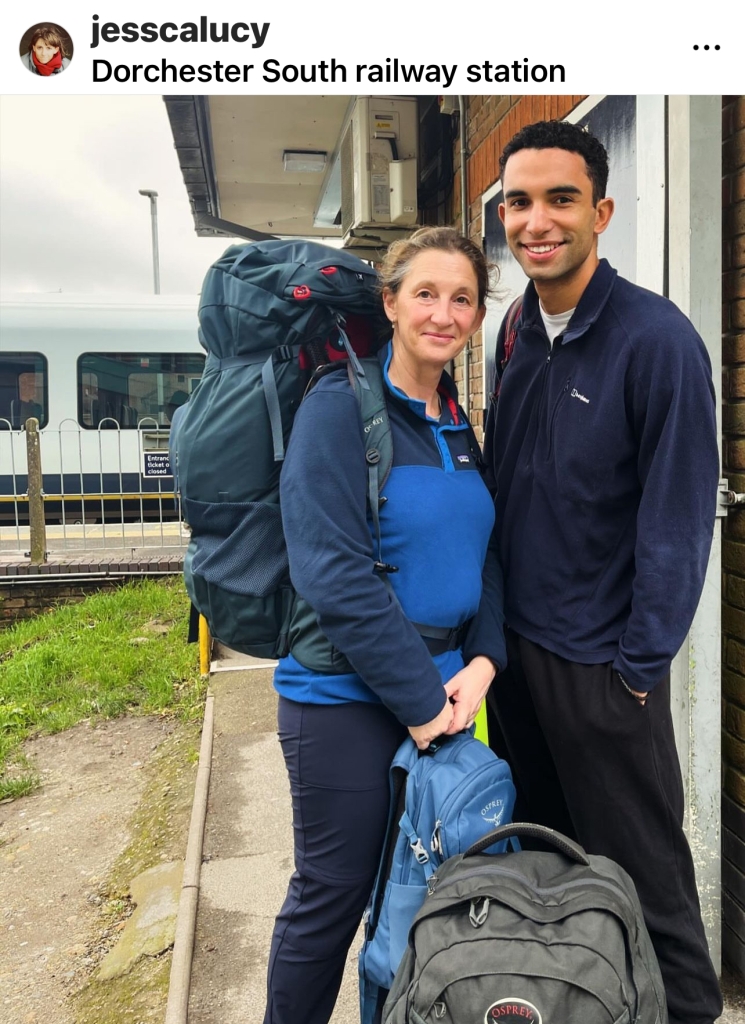
Delhi to Khali Estate
As soon as we were ensconced in an Indian taxi, we were handed a phone by the driver to take a call from ‘Aunty Madhu’ to check we’d arrived safely – giving us an immediate sense of being extremely well looked after which continued throughout the trip. After a night in a Delhi – where we could have done a tour, but frankly couldn’t be bothered with all that damn honking (already a good sign of our compatibility) – we got a three-hour train then a five-hour taxi to Khali Estate – where it felt like we’d arrived at the very edge of the industrialised world: which it turned out, we had.
The first night we met the owners of Village Ways and Khali Estate, Manisha and Himanshu Pande, who told us something of their home’s illustrious history. Built in 1874 by Sir Henry Ramsay (one of the ‘better types’ of colonialists), Gandhi used it as an ashram for five years, and Nehru’s sister holidayed there, ‘surrounded by luscious plums and peaches’. Today it’s part of the Binsar Wildlife Sanctuary in the Almora district of Uttaranchal. A bungalow perched on top of a hill surrounded by pine and oak forest and simple but comfortable circular rooms, on a good day (apparently) you can see the vast panorama of the snow-clad mountains of the central Himalayas. We couldn’t, but we did see the most glorious sunset.

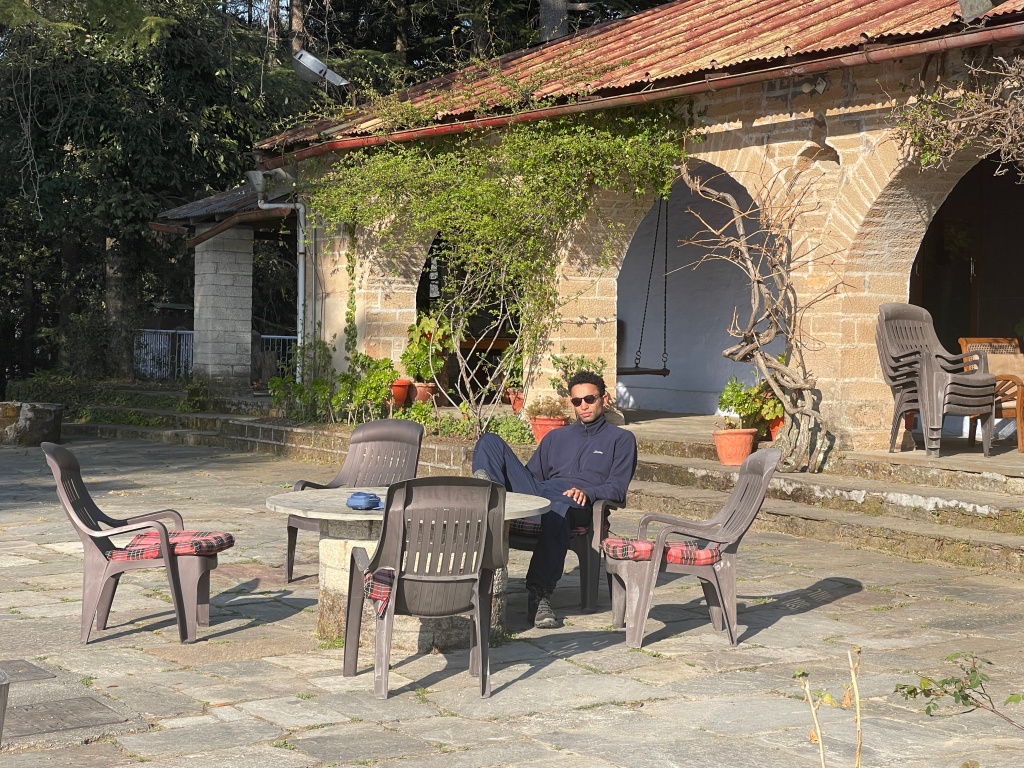
The couple created Village Ways in 2005 as a social enterprise, working in partnership with local villages and hamlets, most of which were under serious threat of outmigration due to a lack of livelihood opportunities. Others helped, including Richard Hearn, who founded Inntravel in 1984; making him a pioneer in rural active tourism in Europe. And for 14 years the organisation flourished, seeing the construction of scores of home-stays and welcoming thousands of visitors, many from the UK.
However, like with so many businesses, Covid was disastrous, and the organisation has struggled to rebuild its numbers of foreign tourists, while some of the homestays began to grow dilapidated through lack of use. One of the things the couple did was to cancel the loans they’d agreed with the villages when each built their tourist accommodations. ‘We’d always said they’d be cancelled in the event of something catastrophic,’ Himanshu told me, ‘and this seemed to be it.’ We spent the evening chatting about how they might increase their numbers again, particularly within the younger age bracket (Jai suggesting that hostel notice boards was one of the best way of targeting backpackers). ‘Do you think your age group would enjoy the experience,’ they asked him, slightly doubtful, ‘I think they’d love it,’ he said. ‘It’s a long way off the beaten track, but that’s one of its attractions’. Let’s hope, I thought, listening to him.
12 km: Khali to Dalar (meaning: dollar, ‘priceless’)
We had a leisurely departure the next morning, having been introduced to our two guides, Ashirward, (soon known by his nickname, Goodu), and Mr Bhupal (soon known without the Mr). Goodu was Jai’s age, which was unexpected, and spoke excellent English, while Bhupal spoke less, but more than made up for it with his wonderful air of calm, and gentle nature.
In the early (ish) morning, the pine forests were bathed in light and we were soon passing goatherders and groups of women on their way to work, machetes balanced on their heads. Of course I was immediately asking a thousand questions and learned that Goodu had trained and briefly worked as an engineer, but decided to return to his village to work as a guide and birder. I wondered why he loved birds so much and was told, ‘Because I live in a bird sanctuary,’ as if I’d failed to see the obvious. (It does happen, earlier in the day I’d felt the need to check with Jai in which mountain range Mount Everest sits).

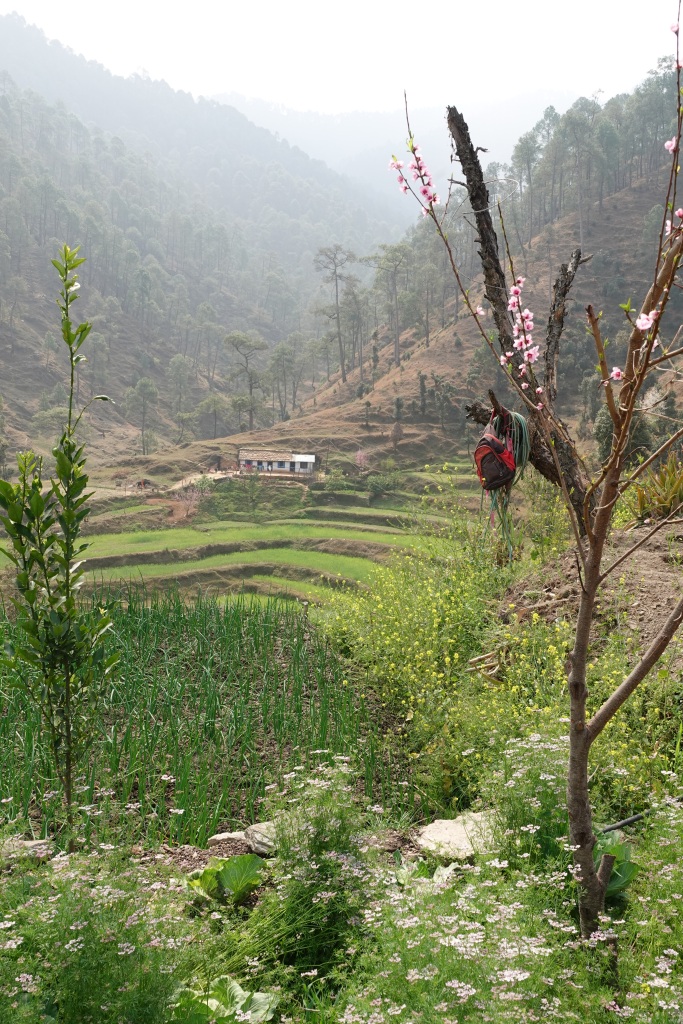
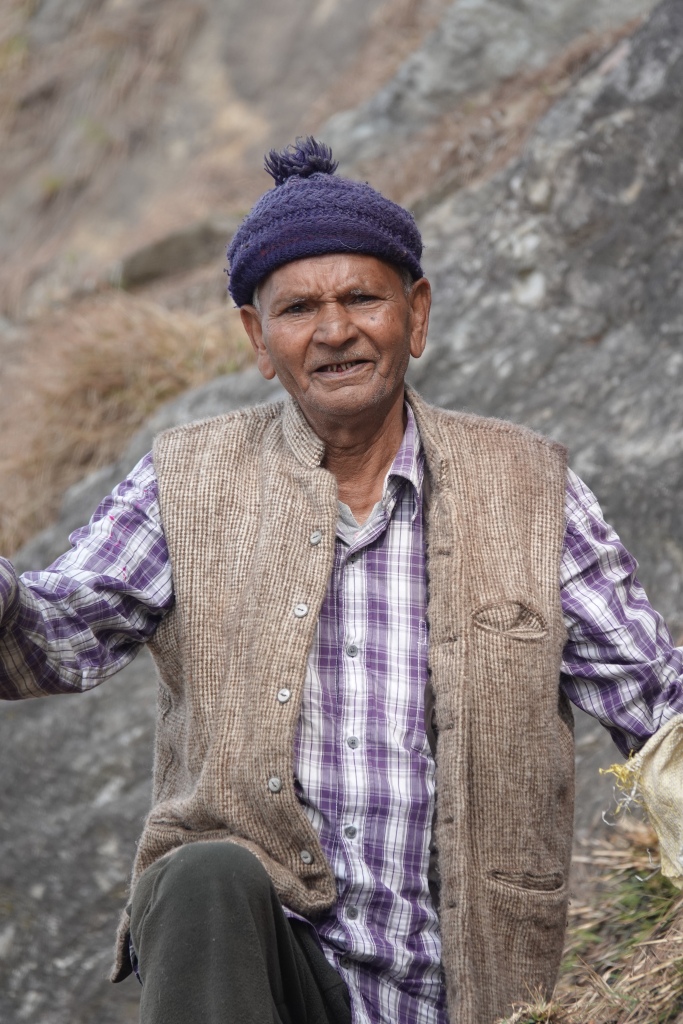


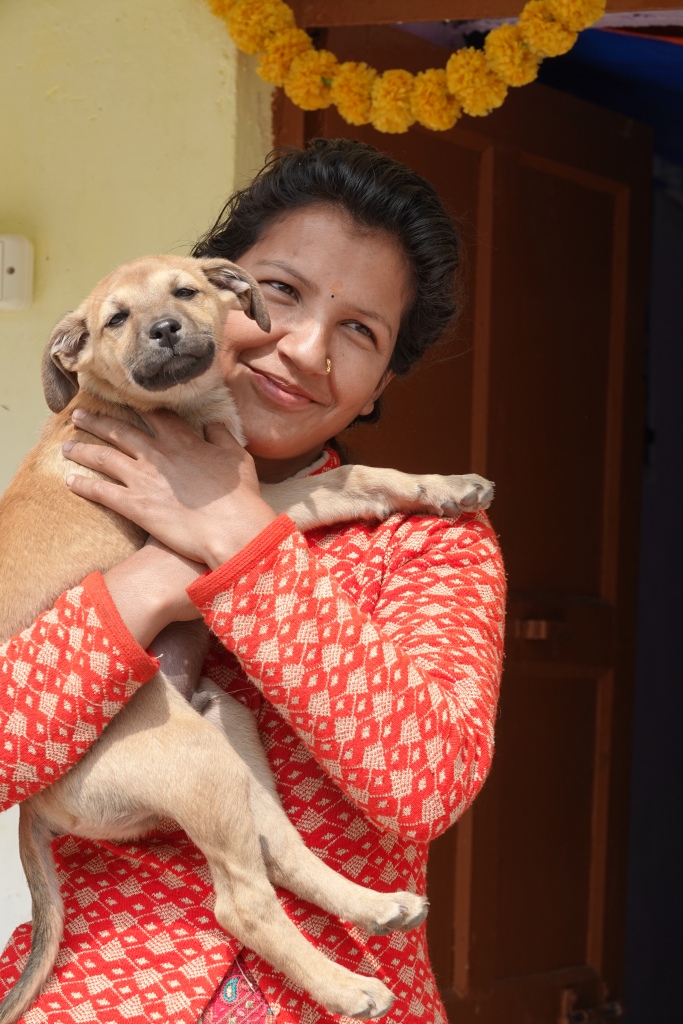


We saw plenty of leopard scat (never a leopard), wild orchids, more goats being taken for their daily constitutional, houses with neat cottage gardens, green wheat fields speckled with purple flowers, and cows chewing the cud by a pond in Goodu’s favourite meditation spot. Generally, other than livestock we didn’t see that much wildlife throughout the week – lots of brightly coloured birds, and we heard an owl, plus we saw a red fox, some beautiful Grey Langur monkeys, deer and a mountain goat. Apparently, there are 24 recorded leopards in the Park – but I don’t think Goodu has ever seen one.
Talking to him, it soon became apparent how traditional life here still is. There are no (obvious) relationships outside of marriage, many wear traditional dress, and women still move to live with the parents of their new husband. I asked if he engaged much with politics. No, was the answer. ‘Because none of them will build me a road. We have built ten guest rooms on our land, plus we’d like to build a treetop homestay. With a road they would be so much more valuable.’ He told me about two guests who’d booked to stay for a month, but when they realised the road stopped a good few miles from the homestay had cancelled. ‘Couldn’t you make a feature of it,’ I suggested, ‘bring them and their luggage to you on mules or something?’ After all, I reasoned, it’s the very fact that there isn’t a main road that keeps the Park so tranquil. Goodu, however, didn’t seem particularly impressed with my reasoning. And would I really want to walk 5km before I reach my home, as many of these villagers do? Probably not. Particularly when, for instance, carrying an ill person on a stretcher.
Arriving at his family home, we found a hillside garden filled with neat lines of spinach, potatoes, wheat, trees of limes and enormous lemons, a cow and two calves, chickens, as well as their burgeoning homestay empire. I soon caused consternation when I wandered into a men-only temple – and I’d only been worrying about at which point I should remove my shoes. Settling into our homestay at the top of steep stairs (not so great in the night, when you need to do a wee in the outside loo three times), that evening was the first I saw Mum’s diary entry from her stay – which made me quite tearful. But not for long as, wearing baggy silk travel pyjamas, which I’d changed into as I’d failed to pack any after-walking wear, we set off for the first of our many Holi celebrations: gatherings hosted by the women of every house in the village until the last day, which culminates in the men’s event. On the way we passed a traditional house built from brick and mud – which Goodu pointed out as a typical property that had been abandoned when its owners migrated to the city.
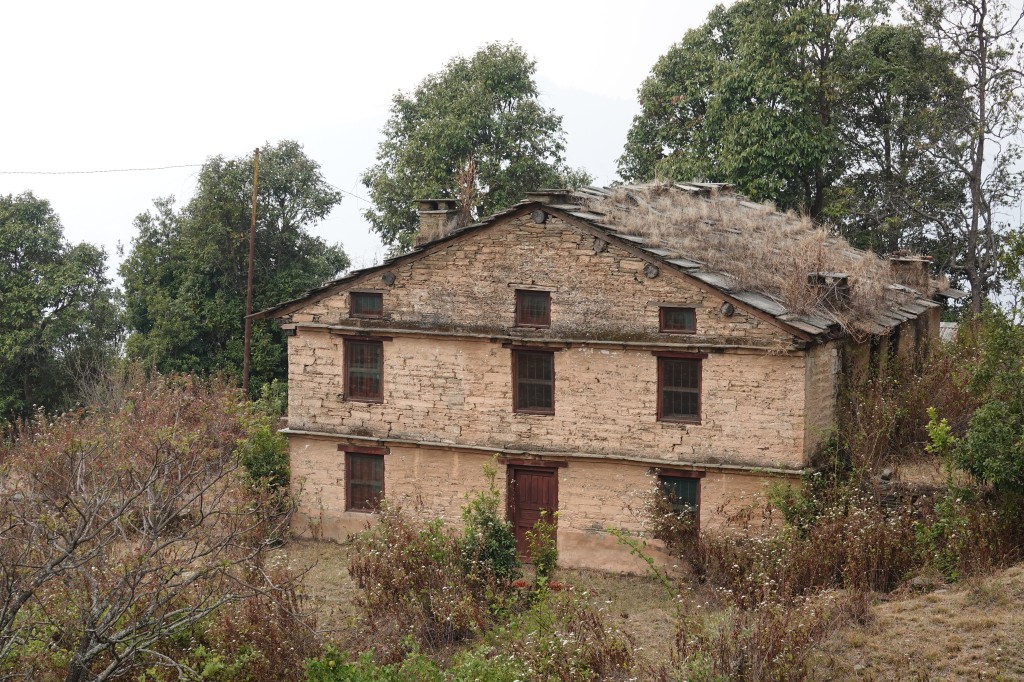
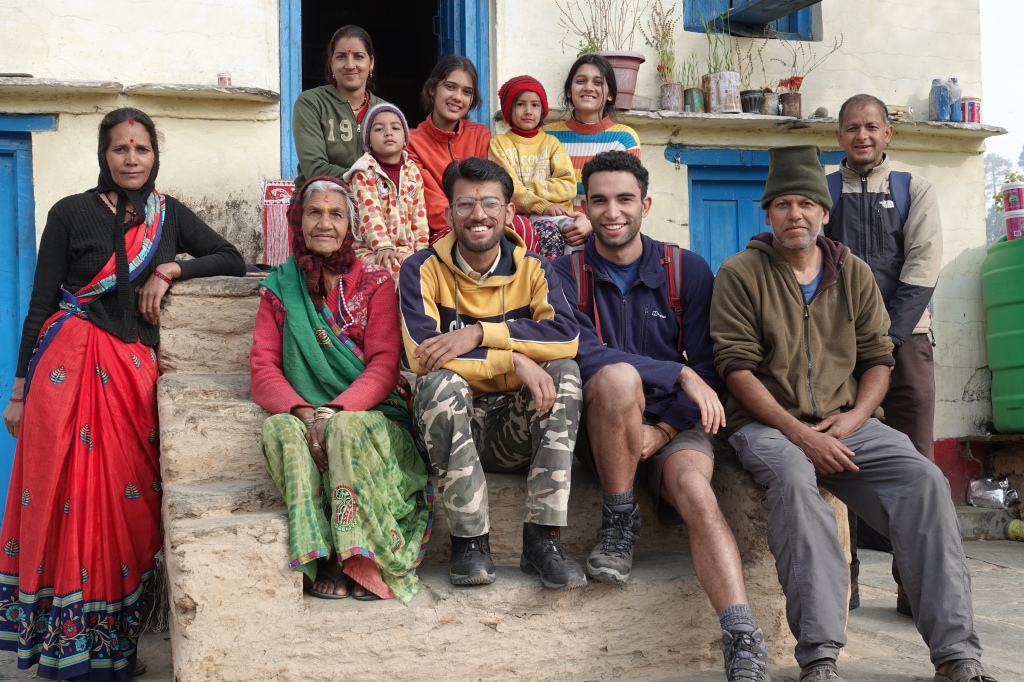



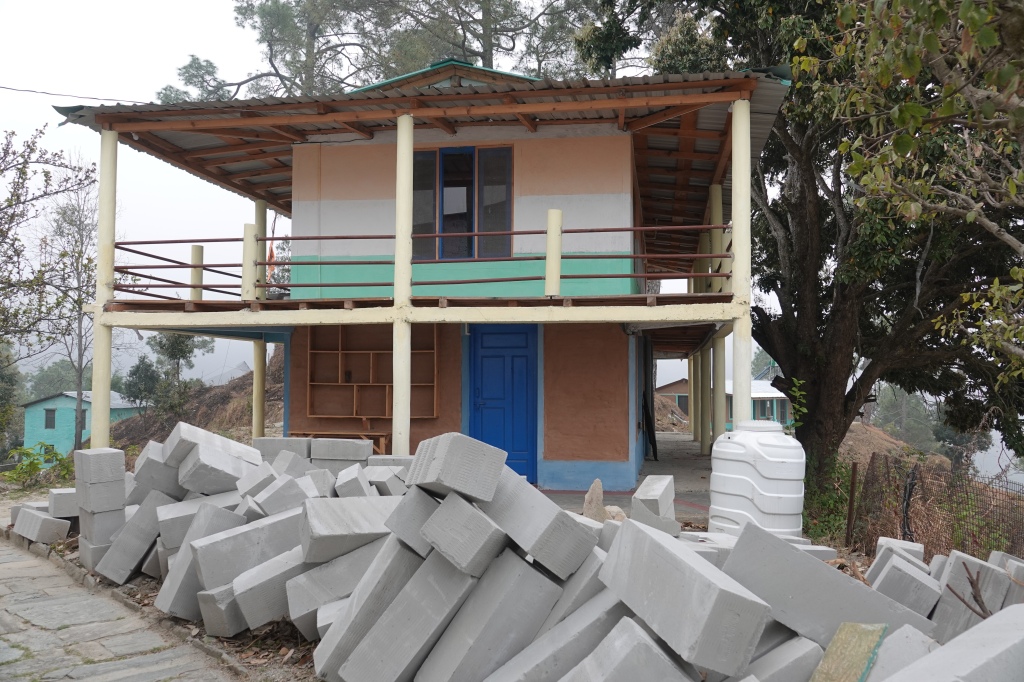
Holi is the annual celebration of love, and at our first event all the women of the village had dressed themselves and their children in red and white. After singing songs, accompanied by a double-headed Dohl drum, the hostess served everyone spiced potatoes with cannabis seed sauce[1], dayglo fried snacks made from wheat and rice flour, Masala tea, and lumps of brown sugar jaggery (made from coconut). I loved how in this house the potatoes were served in pages of schoolwork torn from a book. Reminding me of my first trip to India (over thirty years ago!) when I realised, driving through Trivandrum and watching flipflops being mended and resold, that nothing is wasted. In these hills, most people live on subsistence farming, and I’m sure life can be tough but, Jai and I commented, surely life is better here than living in a meagre shack next to the railway line, as we’d seen coming out of Delhi on the train the previous morning.

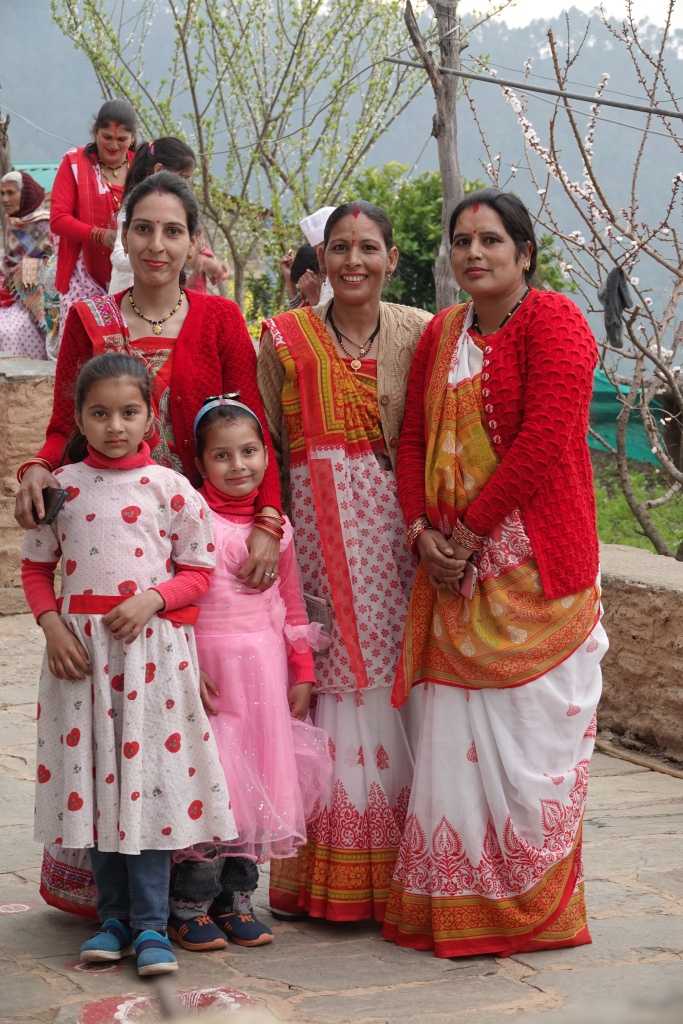

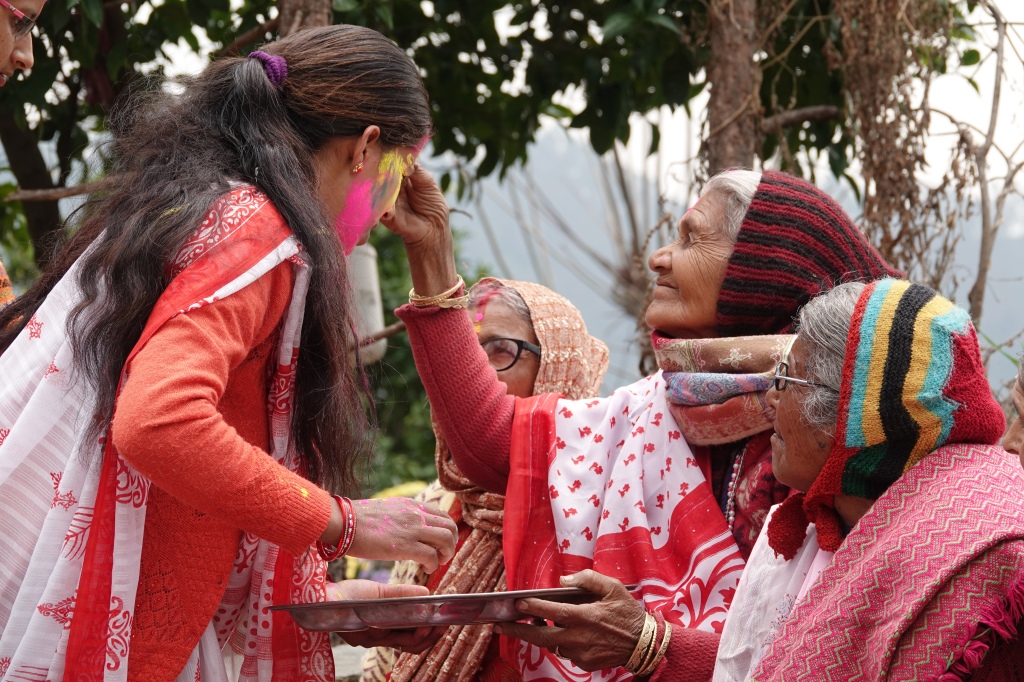
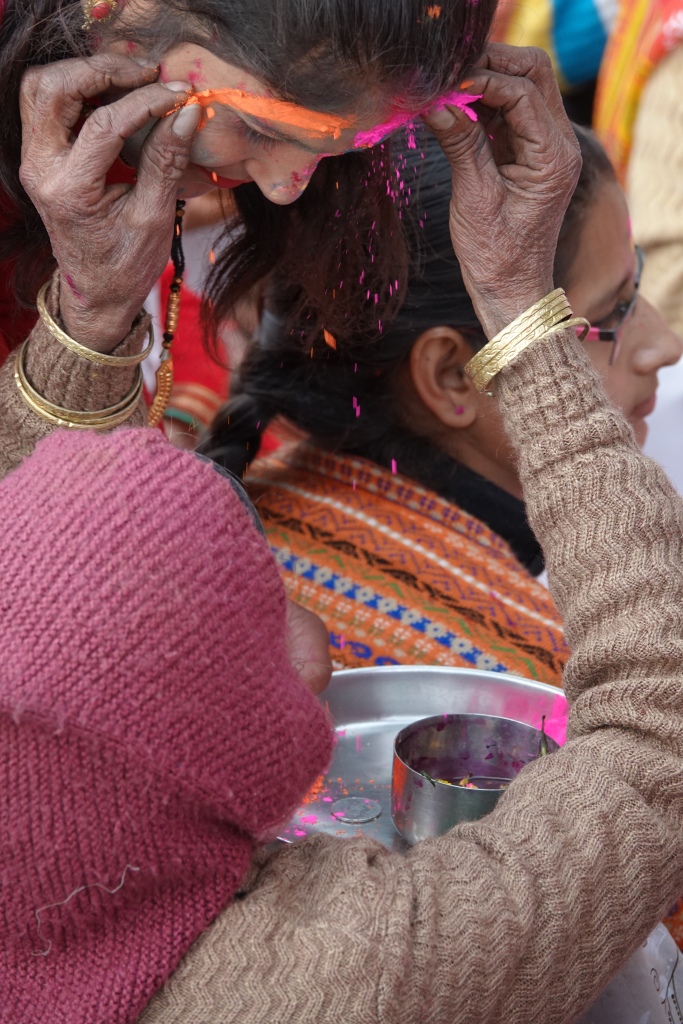

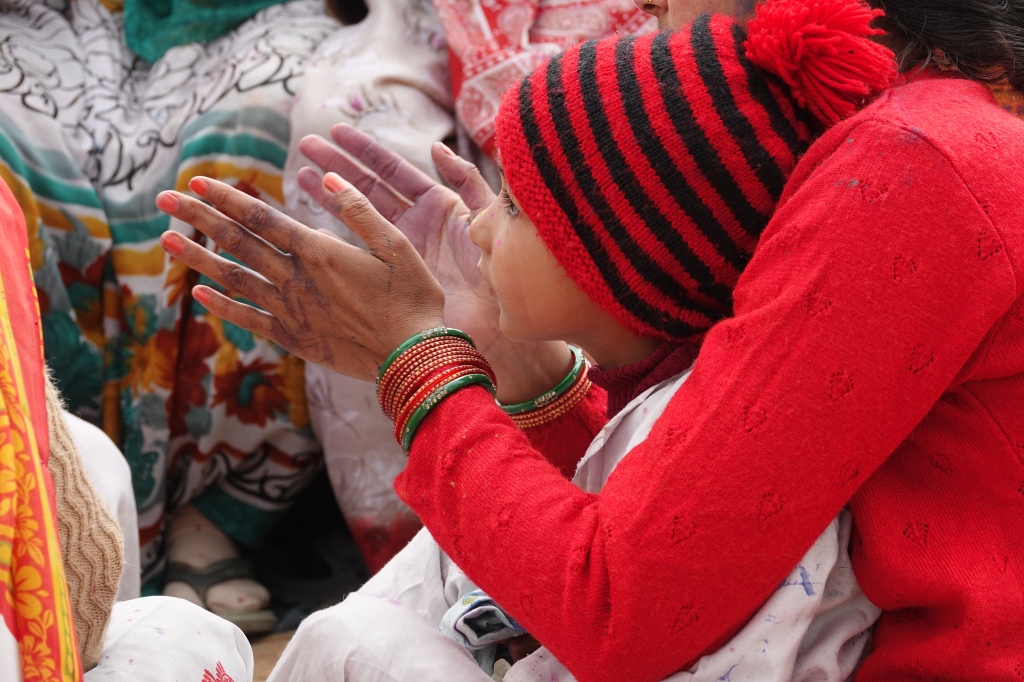
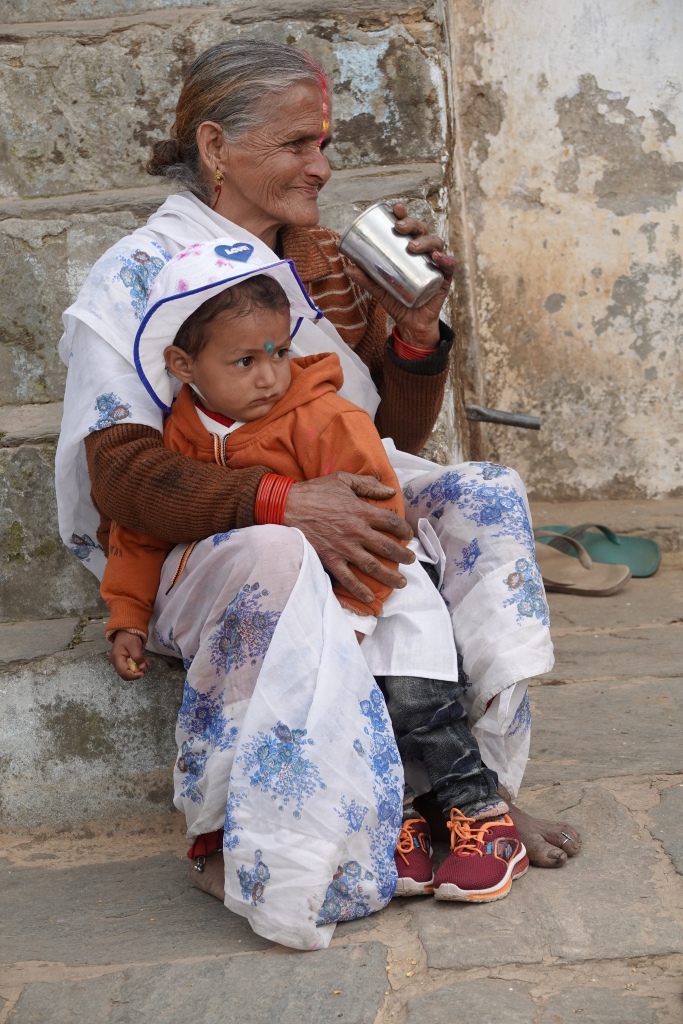
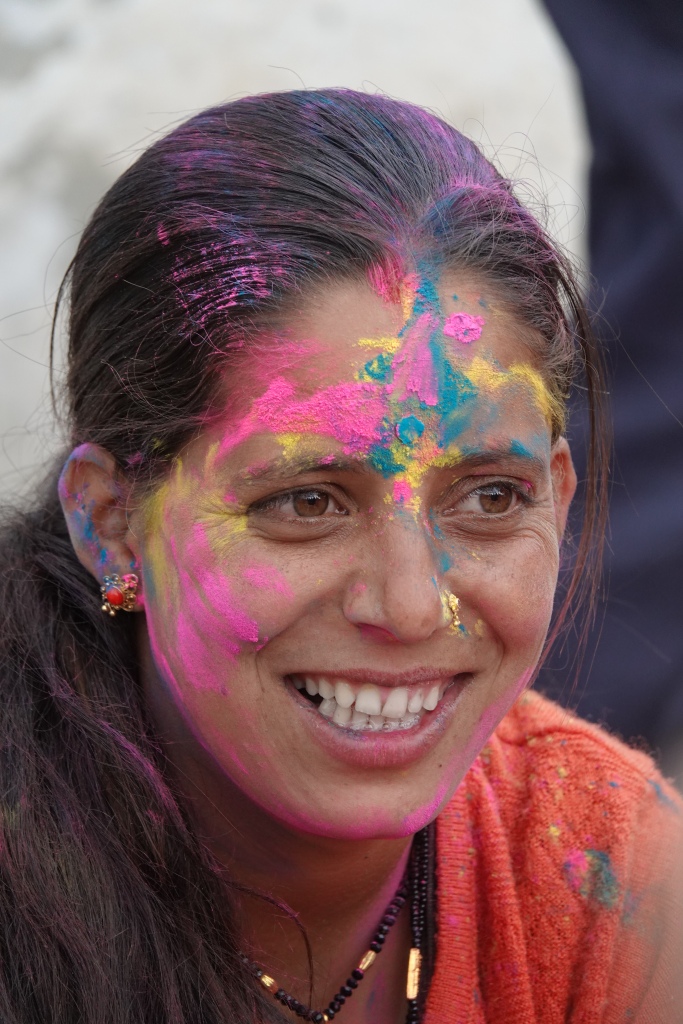

8km: Dalar to Risal (meaning ‘vulture and fox’)
The next morning, sitting writing beneath a blanket of thick mist still hiding the Himalayas, I was aware that, in contrast to the abrasive city honking, all around me was so quiet I could hear the quick flutter of birds’ wings passing through the dew-sodden trees.


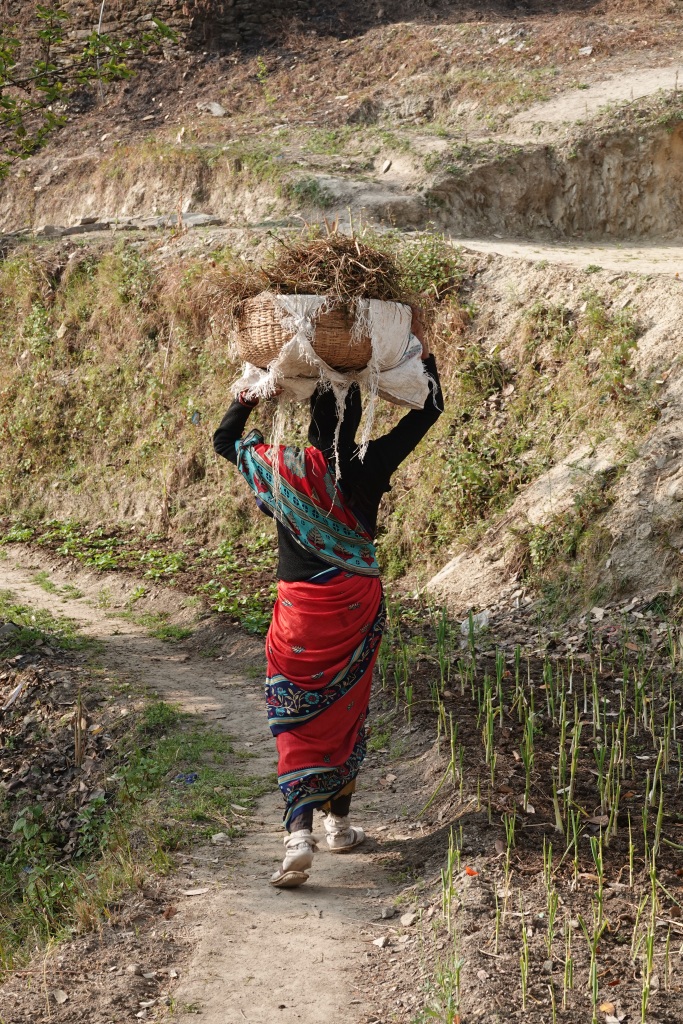
Leaving the hamlet down a steep path, we passed the carcass of a cow, probably killed by a leopard. In order to stop the villagers’ retribution, the government pay them £37 for a dead cow, £30 for a bull. This got us on to a discussion about wages, and Goodu said that 400 rupees (£3.77) is the minimum daily wage, maybe 600 for a labourer – and as an indicator, a cup of tea costs 10 rupees. Watching men (probably from Nepal) lug huge rocks taken from a river on their backs, we were once again aware of how hard life must be for many of them.
In a land of hills, where every metre of fertile land is used for crops, we passed a ‘cricket pitch’ squeezed onto a terrace on the side of the hill – noting that any missed catches would involve a long run down. It was lovely walking along, listening to Jai and Goodu bonding over an animated conversation about cricket. (Mahendra Singh Dhoni was a local boy.) Two twenty-one year olds, with very different lives, still having quite a few things in common – sport being a common uniter the world over.
The next hamlet came into view all too quickly (in fact we were frequently told to stop walking so fast, Goodu seeming to miss the fact that we were following his lead!), so we were sitting with a cup of tea when our backpacks appeared at the edge of a distant field, balanced on the heads of women from his family. Normally, however, I think it would be the men who carried them – and for most of the time it was –for we were amused to hear that most of the women (Goodu’s mother and sister etc) prefer to live in the nearest local town, Almora, where his younger siblings go to school and the women like the fact that ‘there’s beauty parlours, snacks and fast food’, only returning to the hills for festivals and holidays. Goodu was worried that we hadn’t walked enough, so offered to walk us back to his village, then back again – a generous offer we politely declined.

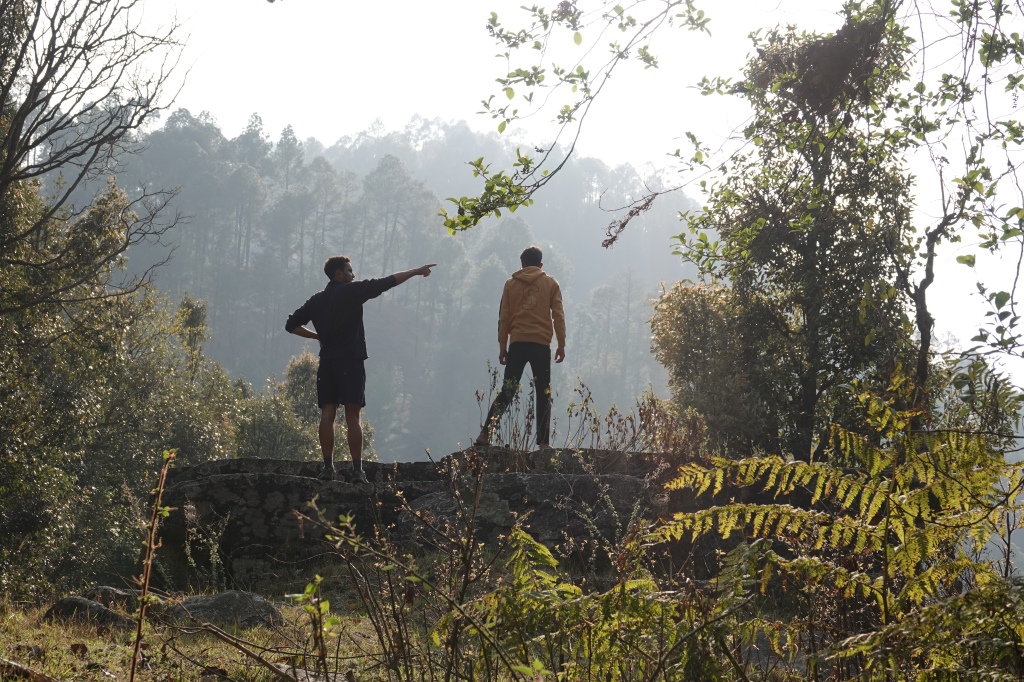

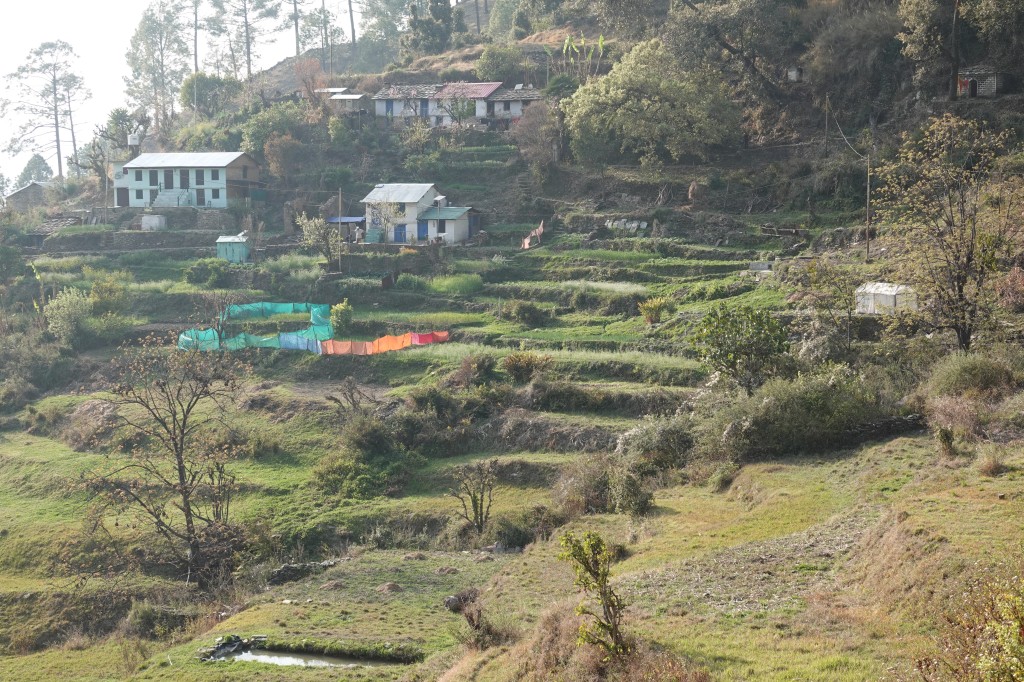
Risal was made up of about eleven women and six men – the average age was between fifty and sixty, and there was one 21-year-old boy. Accommodated in seven houses, we were shown around one of them, painted in primary blues and pinks. I particularly loved the beehive built into the wall of the main room – where twice a year the back is removed in order to access the honey. In our homestay we were delighted to find an en suite bathroom with hot water. (Sometimes there was, sometimes there wasn’t, but you might get the trade-off of the absence of supernaturally large spiders or being able to flush your loo paper!)
In terms of the house layouts, it was good when the terrace was longer, meaning that the cows, chickens and goats could be kept separate from the front of the house. Standing next to two buffalo, tethered on a tiny terrace, we chatted to a lovely young woman who was back home for Holi from university, where she was doing a scientific Masters. Later, watching her pull water from the mountain well to do the family washing, I was struck by how different the two sides of her life must be. Upon graduation, she told us, she hopes to get a job teaching Economics. Throughout the walk, deserted houses kept being point out – the emigration from the area clearly being a great concern to all. Parents want their children to learn English – as it still means better future prospects – but it’s not taught in the local schools. (Perhaps, it was suggested, because the Prime Minister doesn’t speak English either, so it isn’t a priority for him). Before the evening Holi event, Jai amused everyone by deciding he wanted to take a dip in the (turns out rather cold) river.

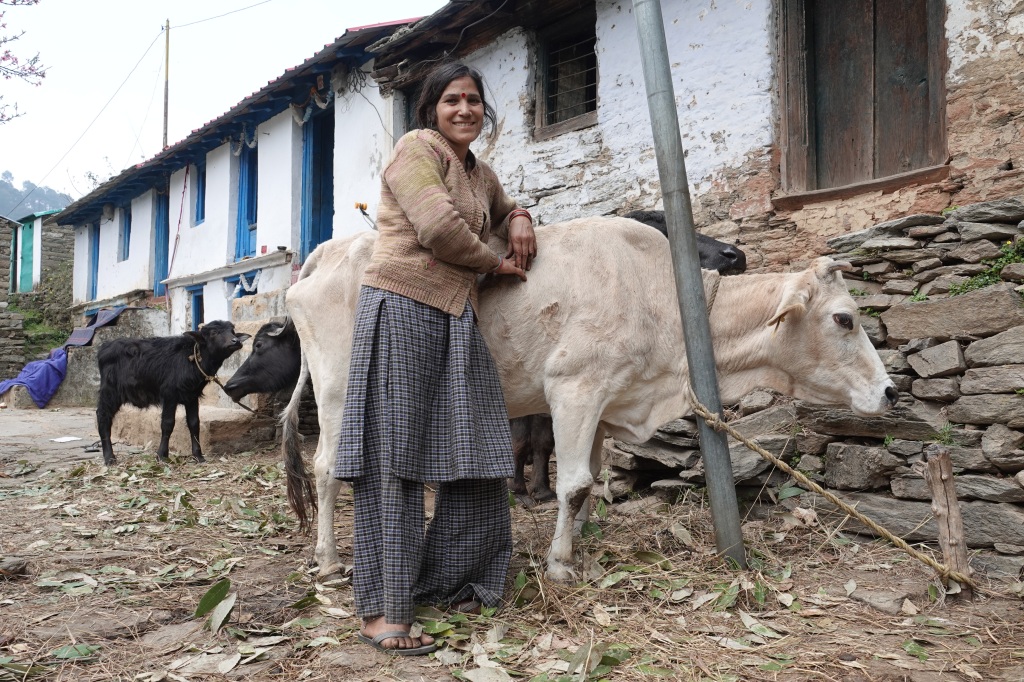


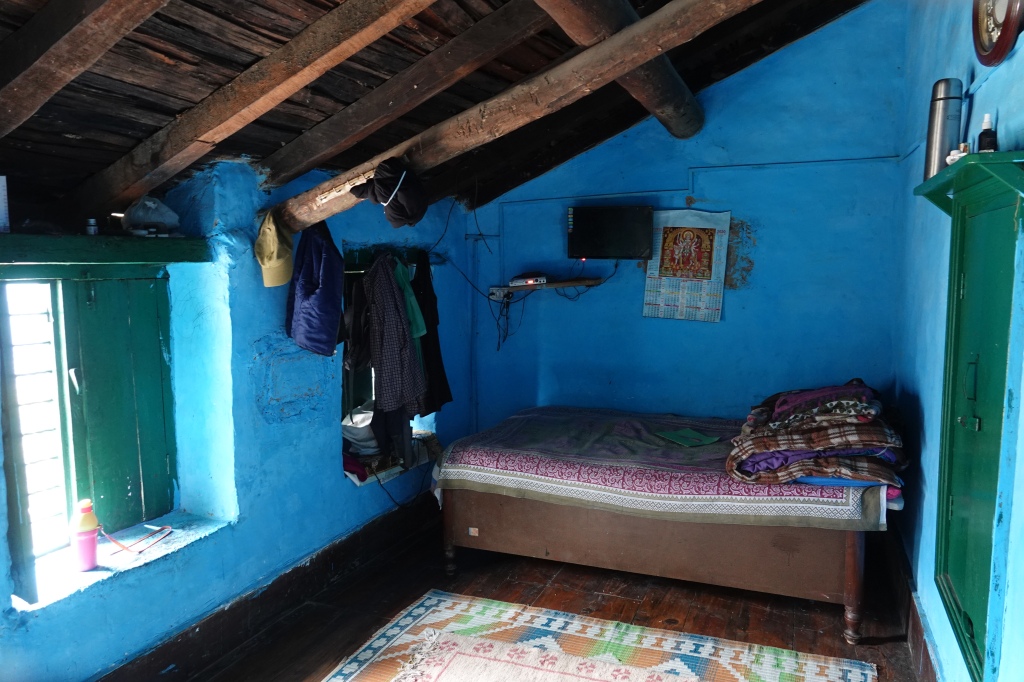
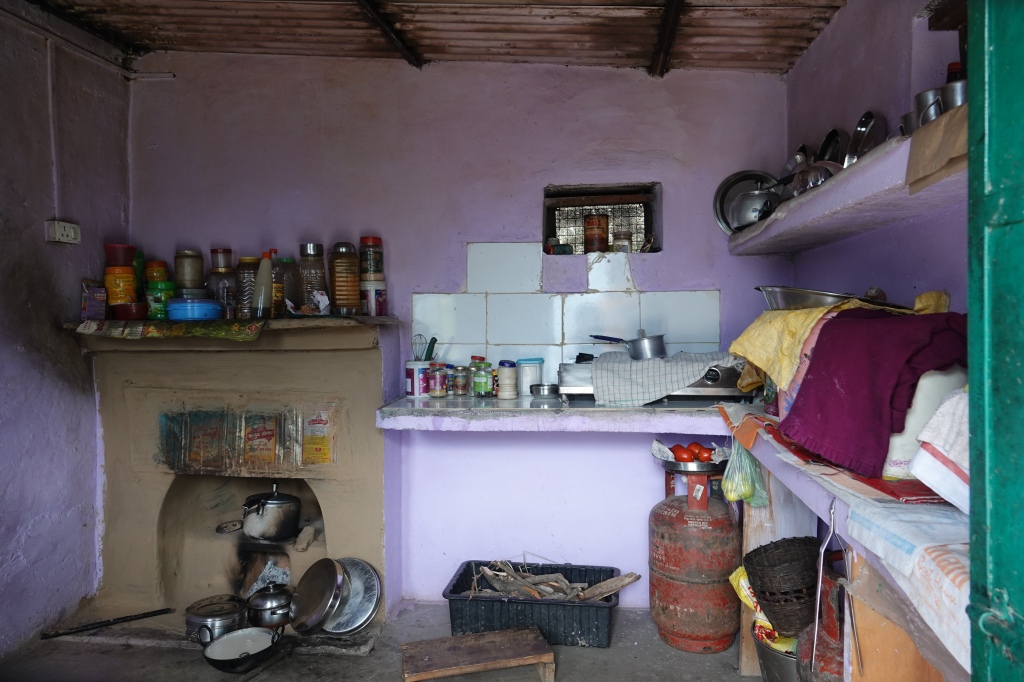

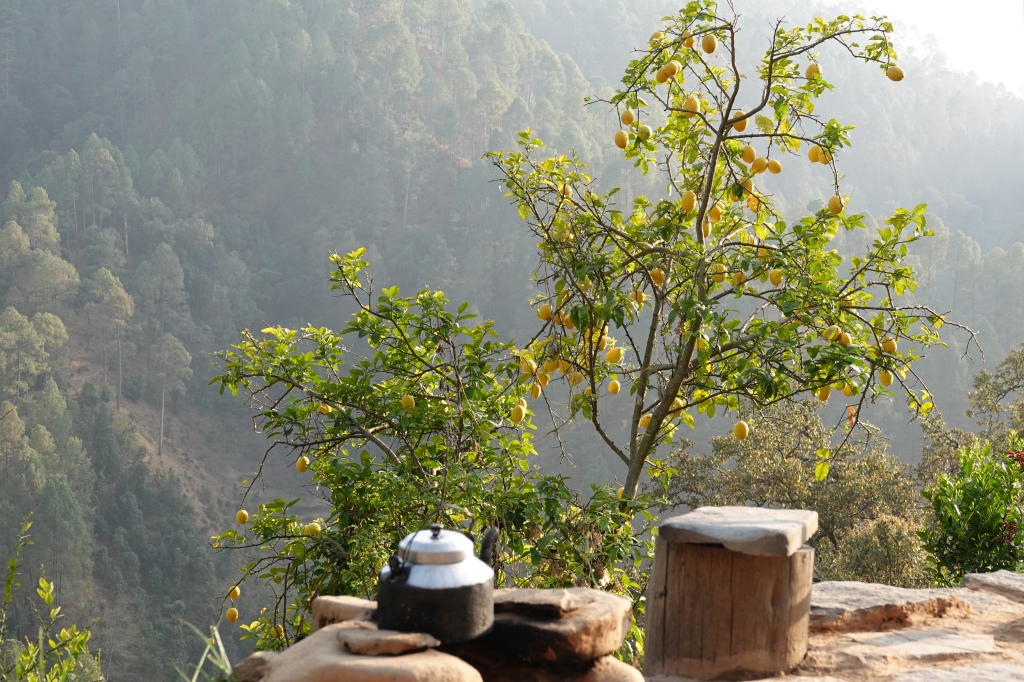



12 km: Risal to Kathdhara (meaning ‘wooden water pipe’)
On the third morning we woke to the sounds of running water and birdsong, still feeling full from the food from the night before (more Holi potatoes and crisps, plus our daily supper of dahl, handmade chapatis and one, possibly two vegetable curries.) The system seemed to be that often the guides would eat what we didn’t – along with their own food. Which made it deeply embarrassing that Jai had helped himself to seconds from one of the curries and we’d been informed they’d have to throw it away as he hadn’t used a separate spoon. Not a mistake we made again.
Today we were walking up to Zero Point, which pulls in hundreds of tourists wanting a photo of themselves in front of the strip of Himalayas ‘for the grid’. And yes, finally, we got to see a portion of the snow-capped mountains through a break in the clouds. Quite the view, when eating your fruit and nuts.
Afterwards, having descended from the hill top, as we sat looking out across a well-manicured green on which cows and sheep grazed, Goodu told us how people pay 800 rupees to enter Binsar Park, then 1000 to a guide for a 2km walk – ‘all for one photo from Zero Point’. Rarely do they stop to see the people who live in the area, explore their way of life, or appreciate the rest of the beautiful scenery. One fascinating element was the temple on the edge of the green, guarded by a reclining priest, who lay there all day (or so it seemed) waiting for any visitors who might require a blessing. Goodu made me laugh, switching out of guide mode and into that of a twenty-one year old when watching a woman enter the temple and exclaiming, ‘Now she’s fat!’ This was after having smooth-talked me, telling me that he’d thought initially I was in my thirties (!) and that I was the perfect Indian size: neither too fat, nor too thin. What a charmer…
Jai was meanwhile engrossed by Matthew McConaughey, listening to him read his memoir on Audible. Hopefully it’s one thing I showed him this trip, that walking and listening to a great book is the perfect combination.
Leading up from the green was a steep path, at the end of which we arrived at General Henry Ramsay’s old office (or second home?), Grand Oak Manor, that he would ride up to via some remarkably good cobble paths (strewn with crimson rhododendron petals) that he’d had built to accommodate his journey. Today it’s a hotel, and I wondered how the guests felt, looking out to the platform where apparently people who’d fallen foul of the law used to be hanged – able at least to enjoy a fantastic view in their last moments on this earth (or before reincarnation).
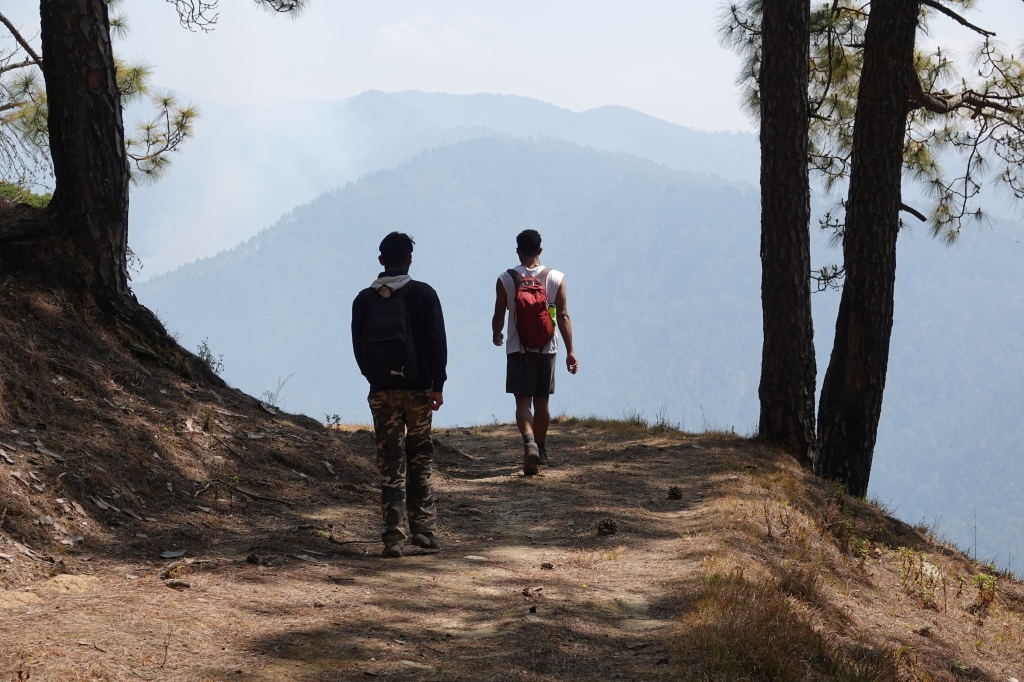
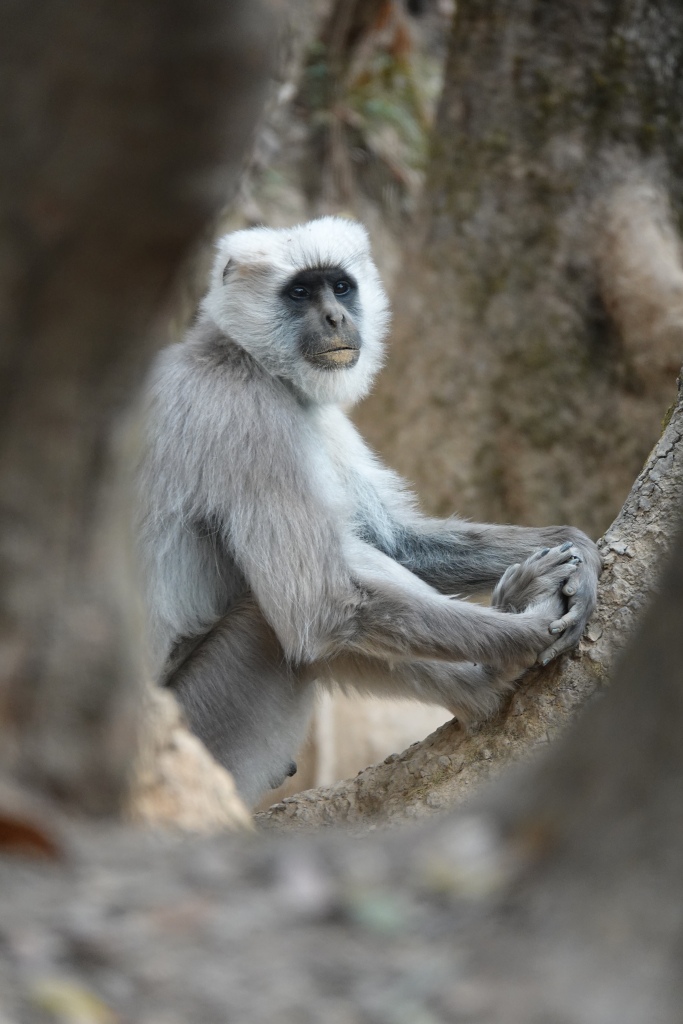

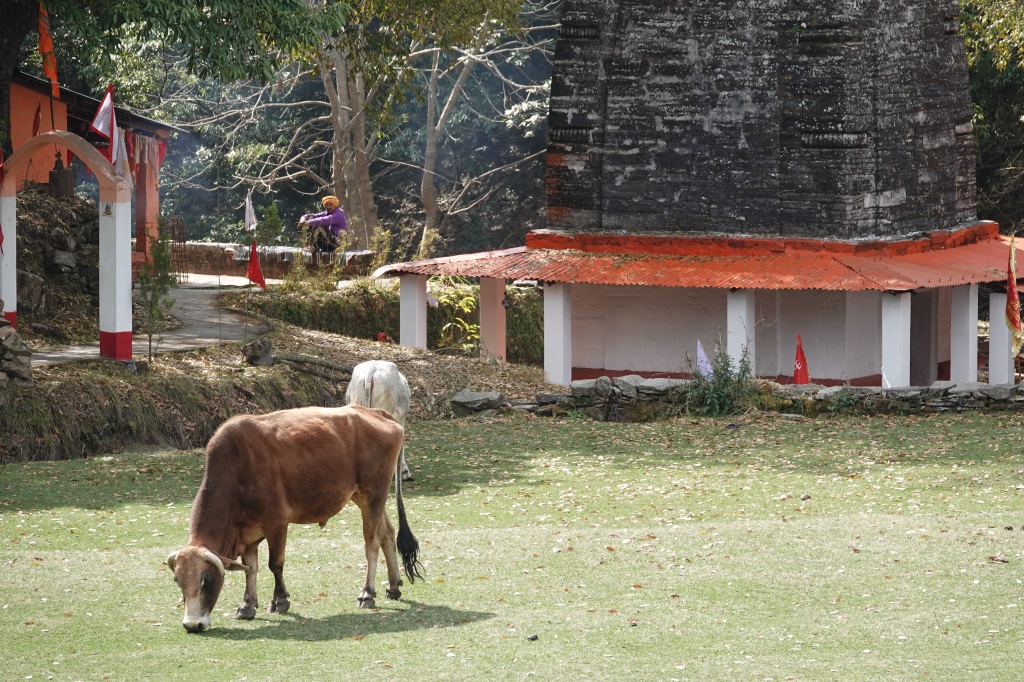
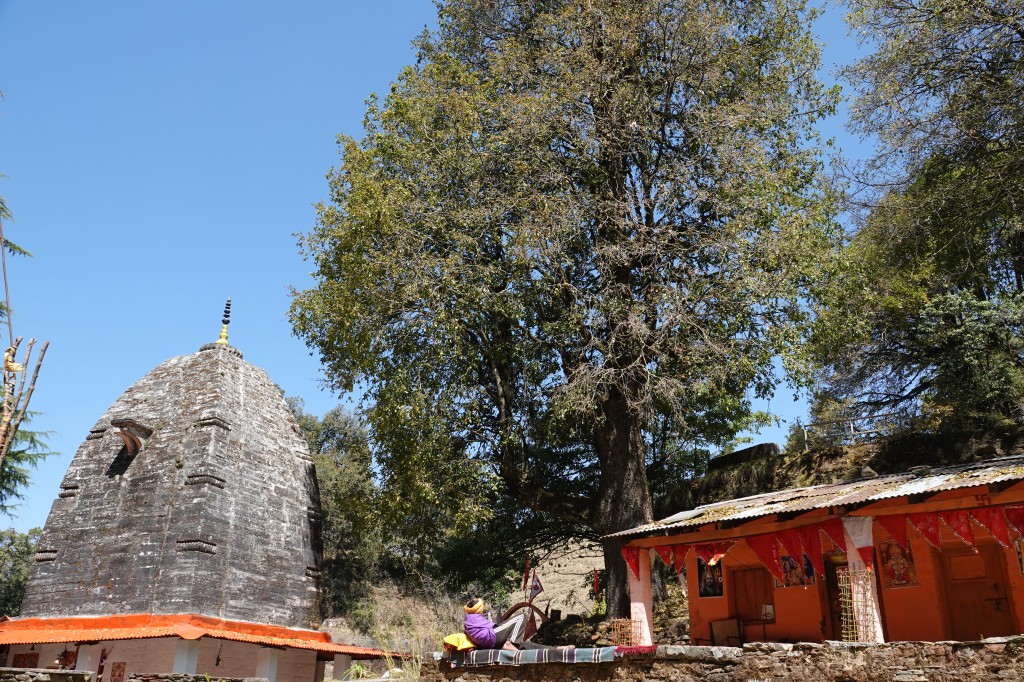
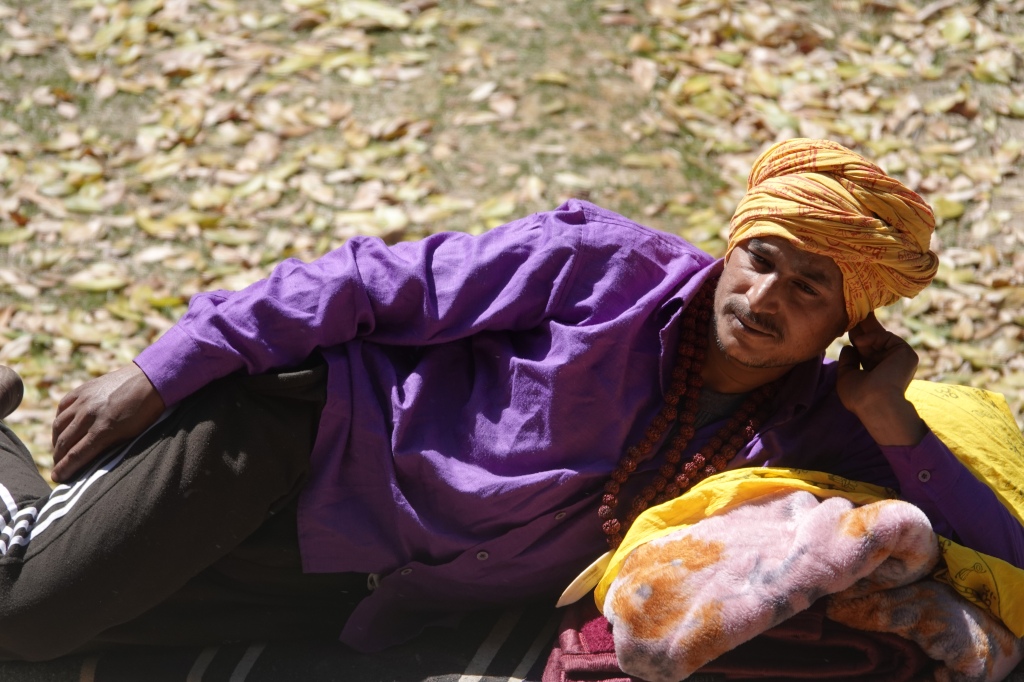
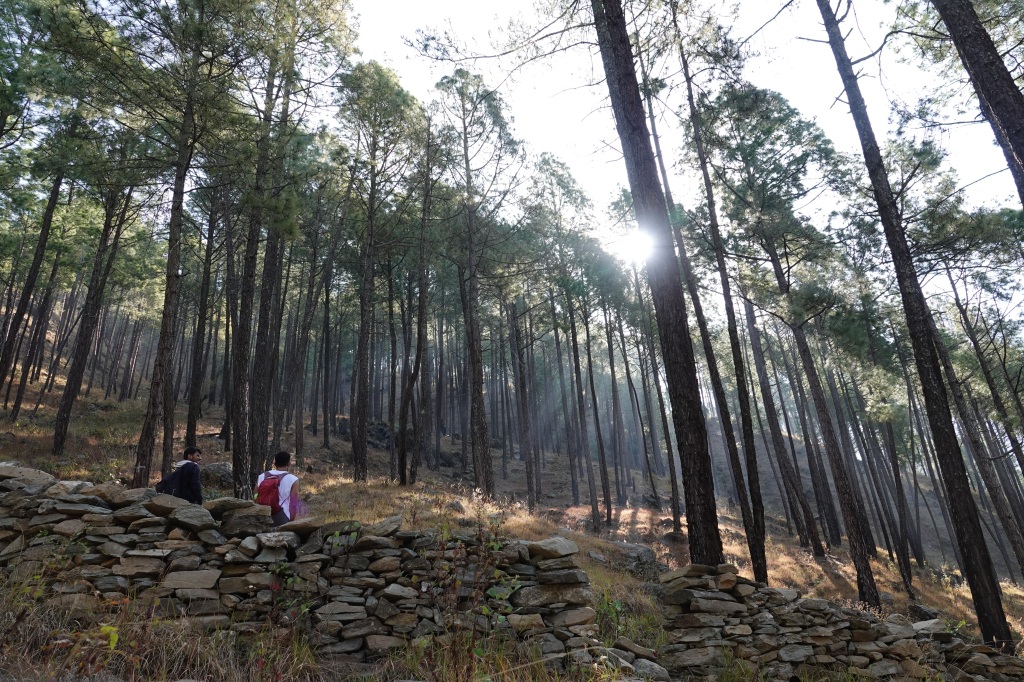
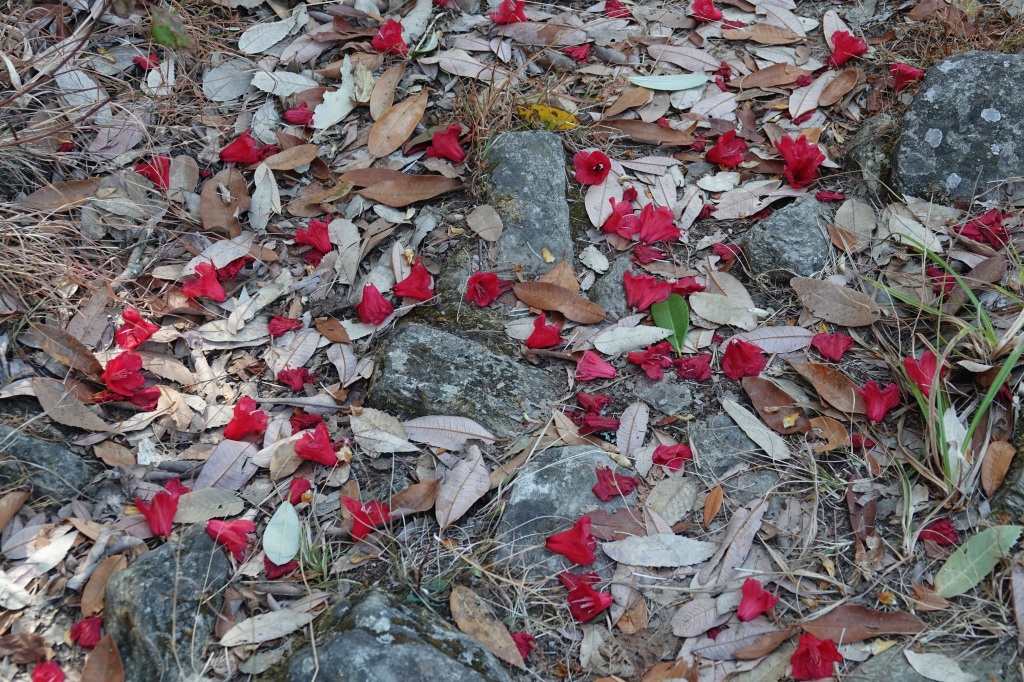
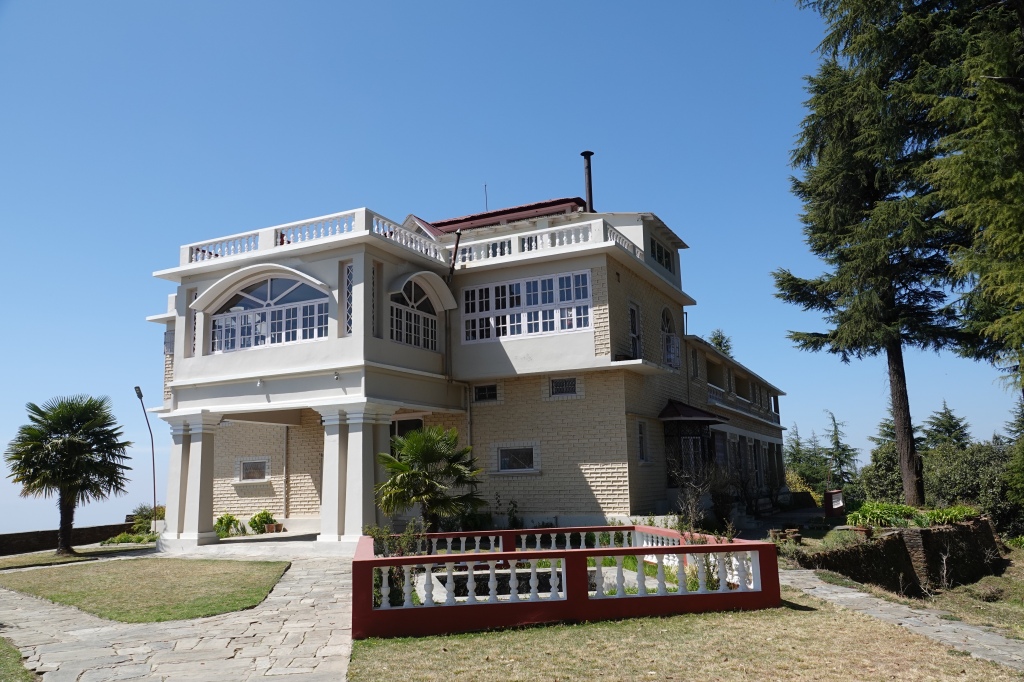
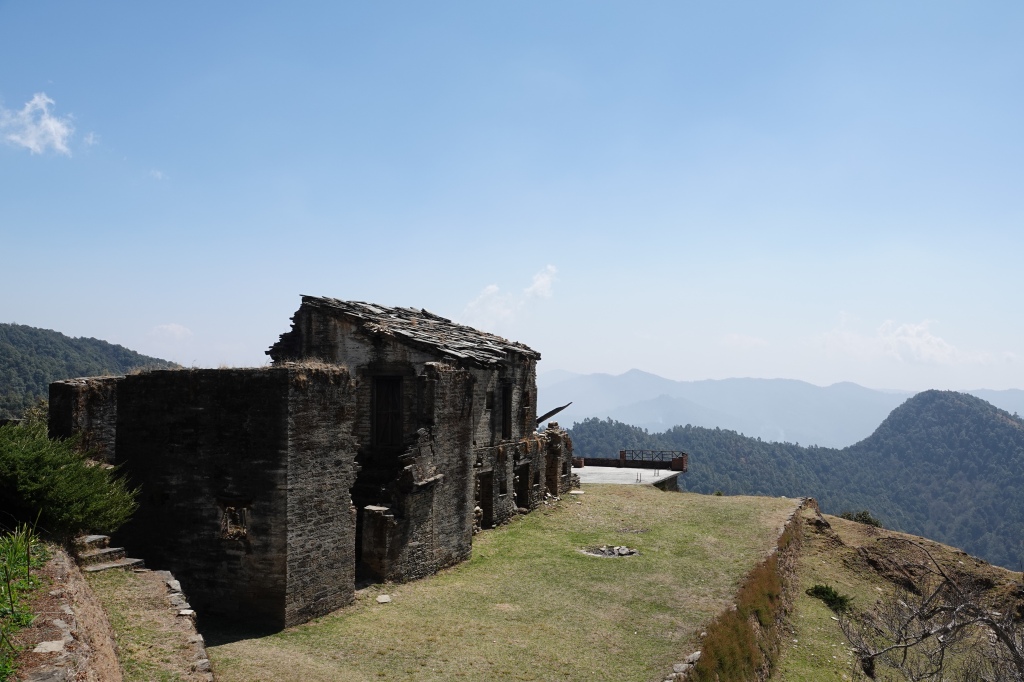
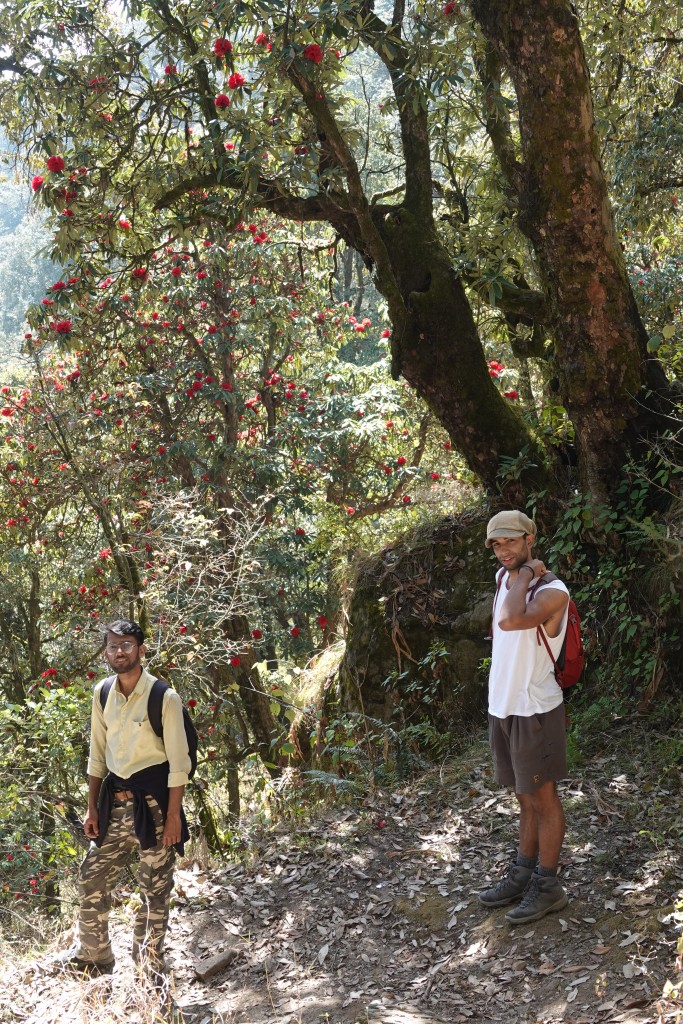
This third hamlet was larger than the others, filled with families whose men had retired from the army. Attending Holi, we watched all the women circle dancing, before starting some dressing up antics. I was soon fitted out in bridal wear, then a sari, happily joining in with the wonderfully festive atmosphere. This included a moment of dancing that, thanks to modern technology (and some excellent internet connections) is immortalised on the internet (nice to have the gaze turned on the tourist for once!)
The vlog is hosted by the very beautiful Mah Bhanu Jeena (who turned out to be Bhupal’s niece.) Following her love marriage (it’s a fifty fifty split between those and arranged ones these days), she moved to the village to live with her husband’s family, and loves her new life. Despite the fact that her husband works in Jaipur, so she only sees him for the occasional festival and other holidays when he can come home – about 20 days of the year, we estimated.
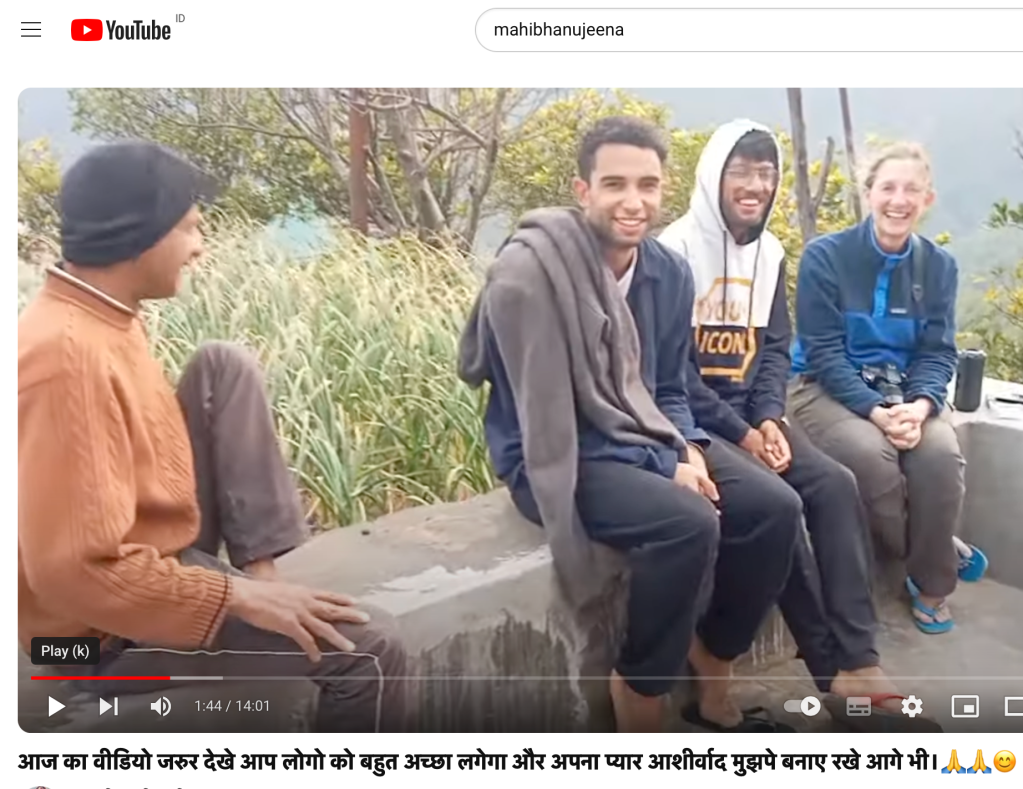
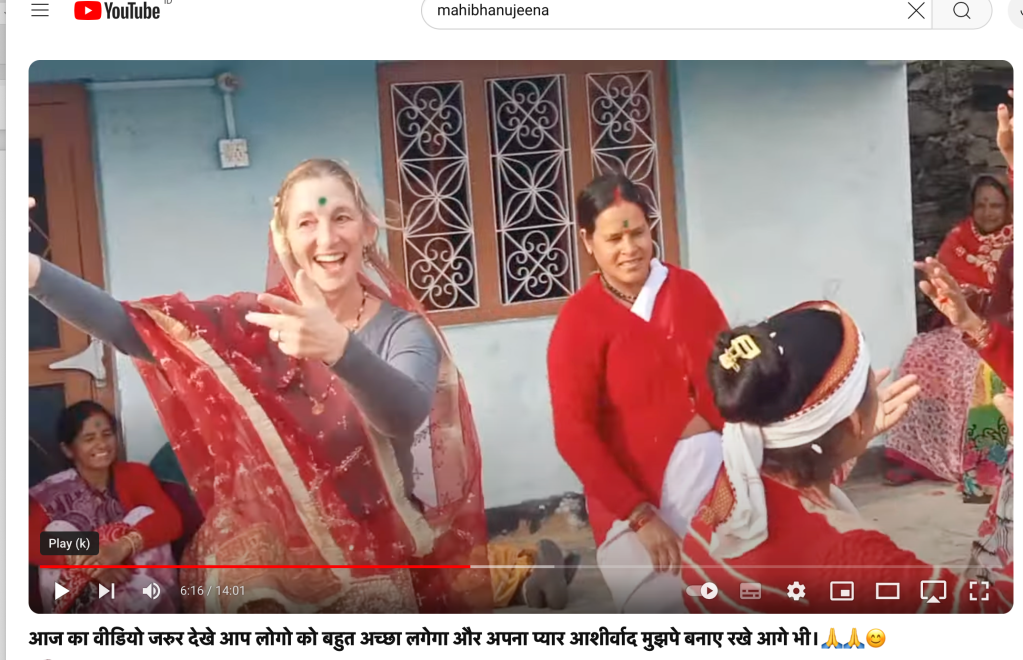

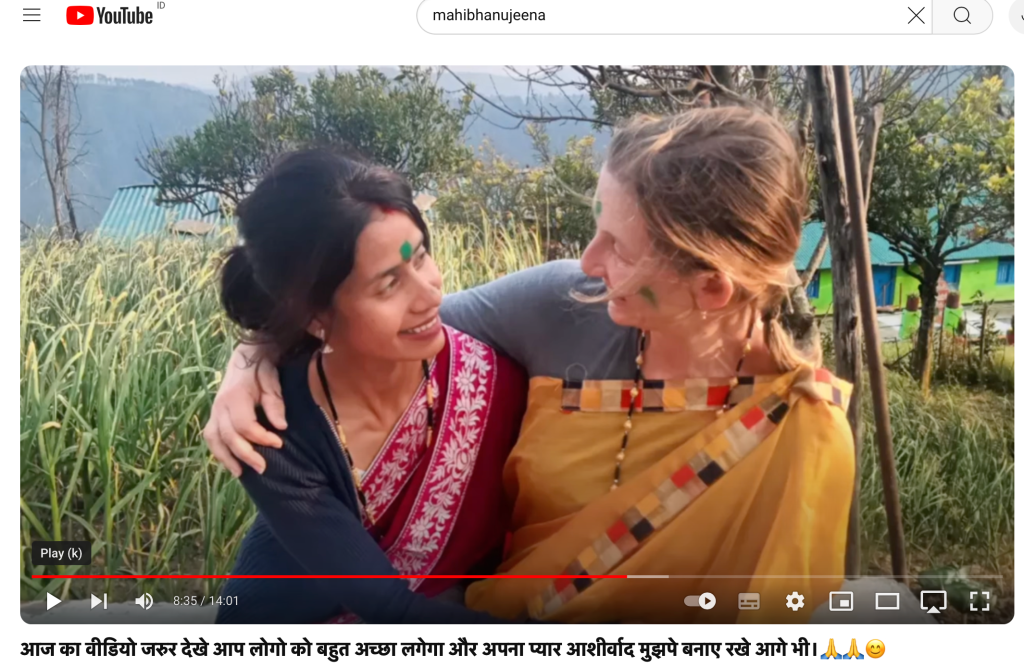
When we got back to our homestay, the night naturally evolved into something very special, where we sat in the kitchen, squatting on low stools and chatting to the villagers as they prepared our dinner – rolling out chapatis and cooking over the open fire. Apparently they could cook on gas or electric rings, but prefer the taste of woodsmoke. Eating a chapati with lemon and sugar (my version of an Indian pancake) Jai and I continued our daily debate about how many I could eat, and still hope to lose weight from walking. (An equation I failed on miserably, as it turned out. Still… perfect size for an Indian, apparently…)
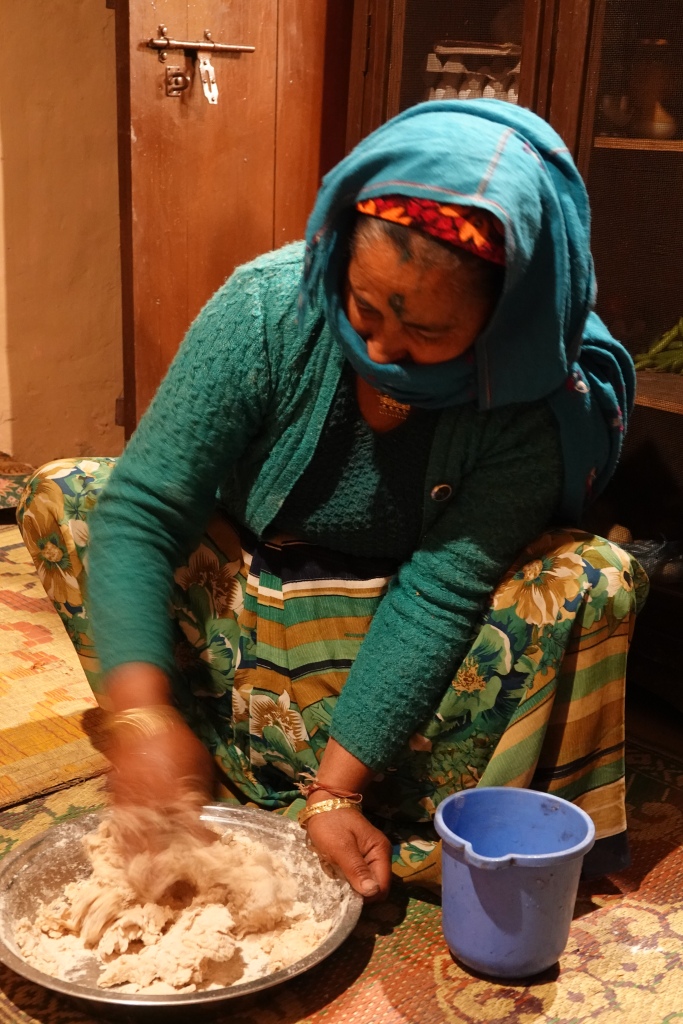
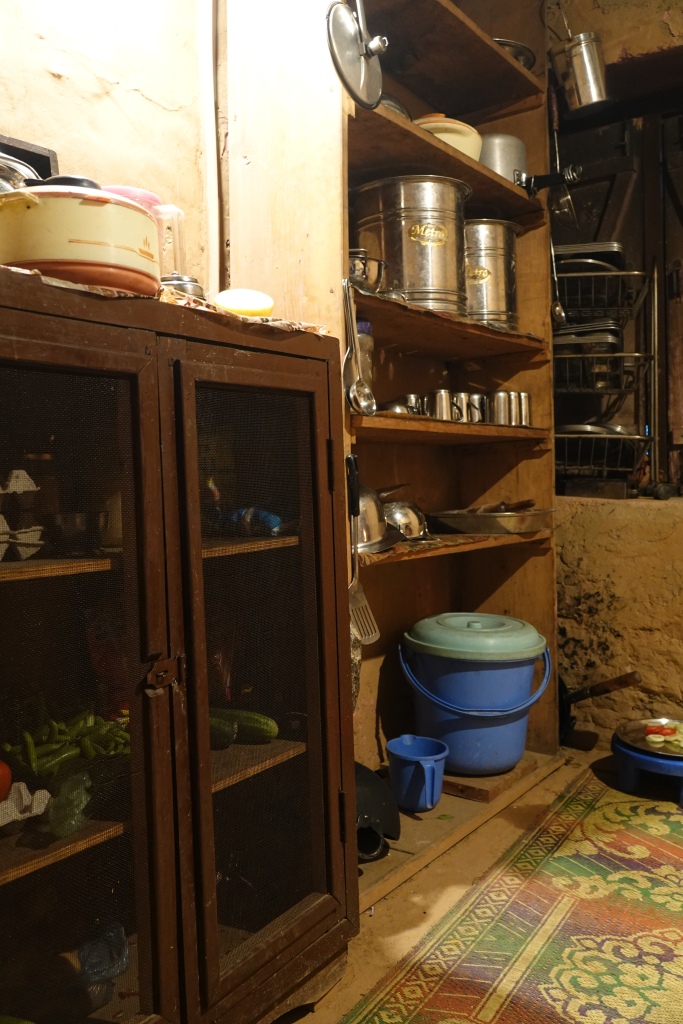
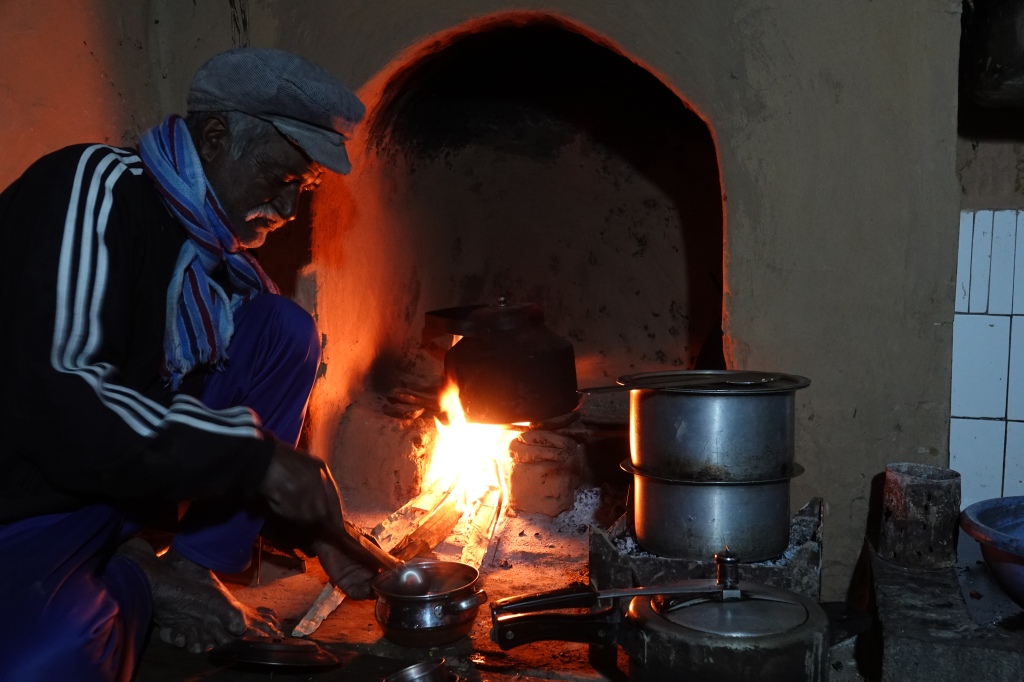

10 km: Kathdhara to Gonap (meaning ‘cow’s foot’)
Today the landscape reminded me of Switzerland, houses picturesquely perched on the mountainside. Although when you get up close to them you realise the poor conditions many of them are in. Today the walk today was hot and very windy, through miles of controlled burnt hills, and when we reached Gonap, Jai retired to bed with a headache – although he woke quickly enough when offered freshly fried pakora.
Sitting on the terrace, I watched a woman below shrieking at a cow as she tried to marshal it through the crop fields, the huge white beast playing peekaboo around the sides of a haystack wigwam while remaining remarkably placid, given all the rocks being thrown at it.
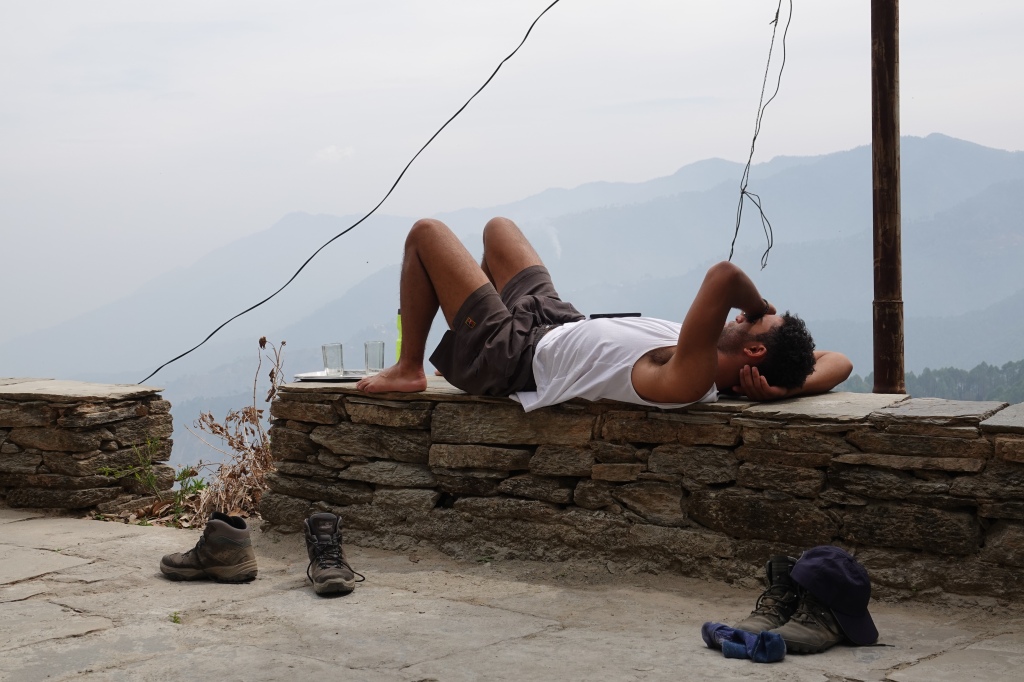

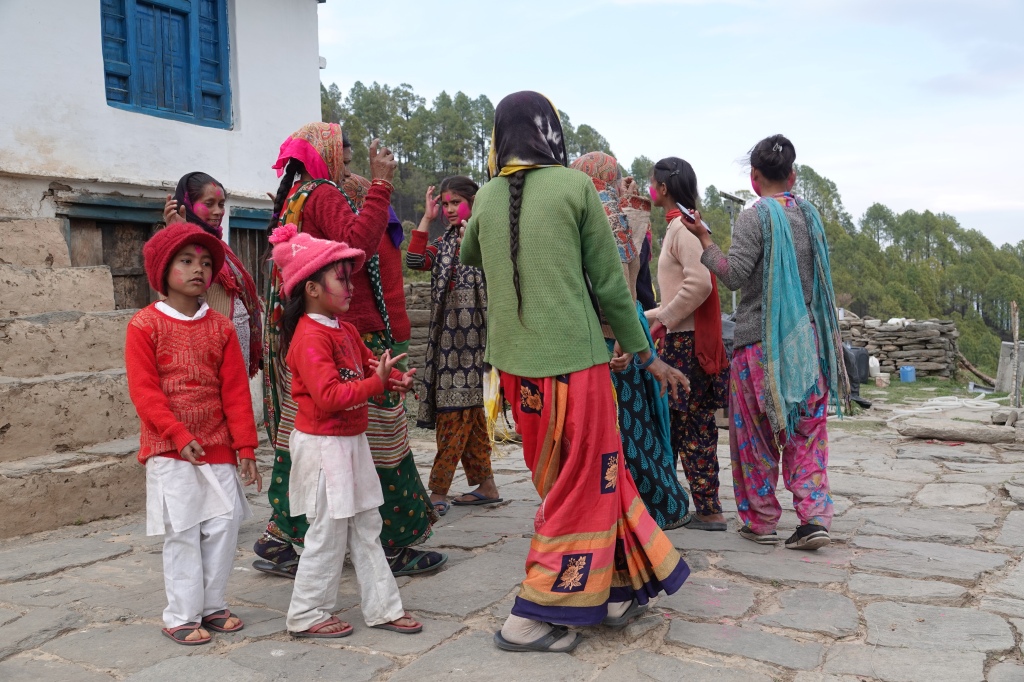
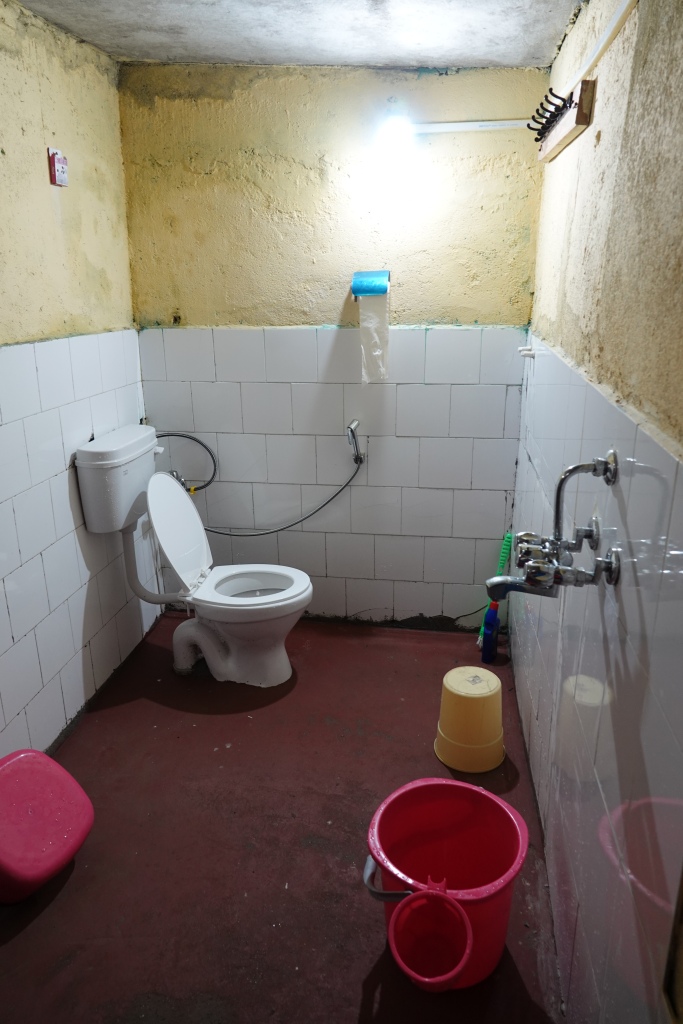
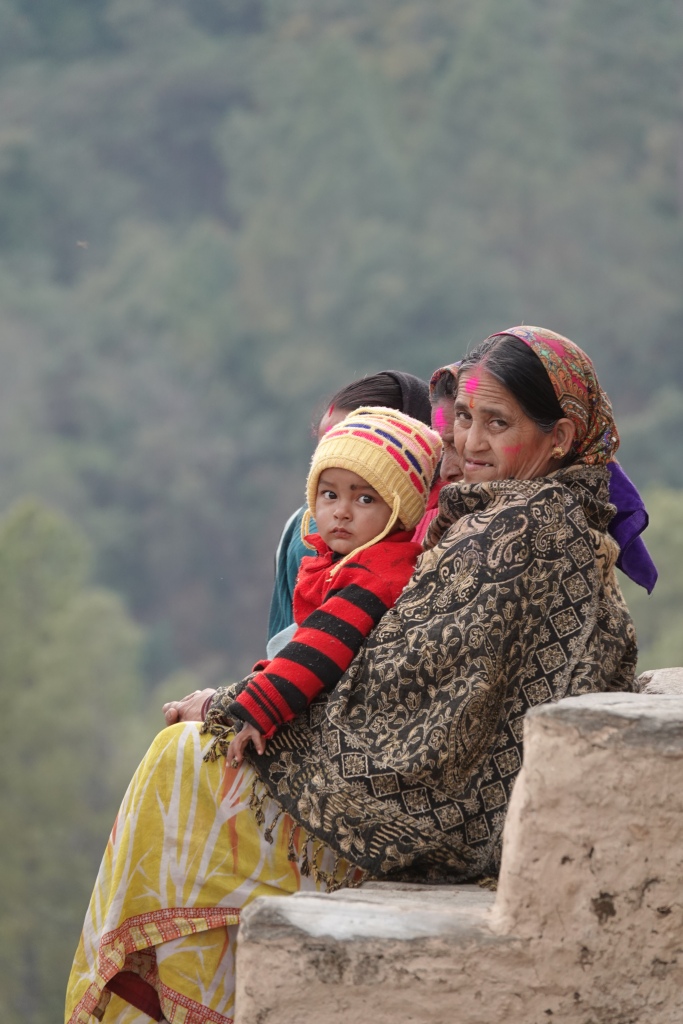
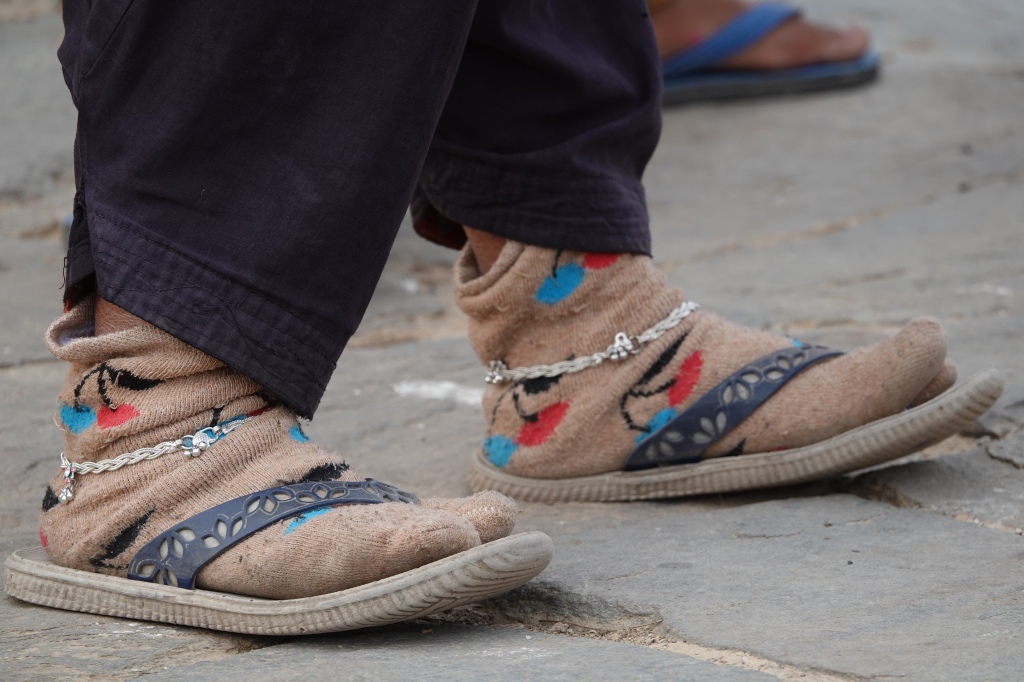

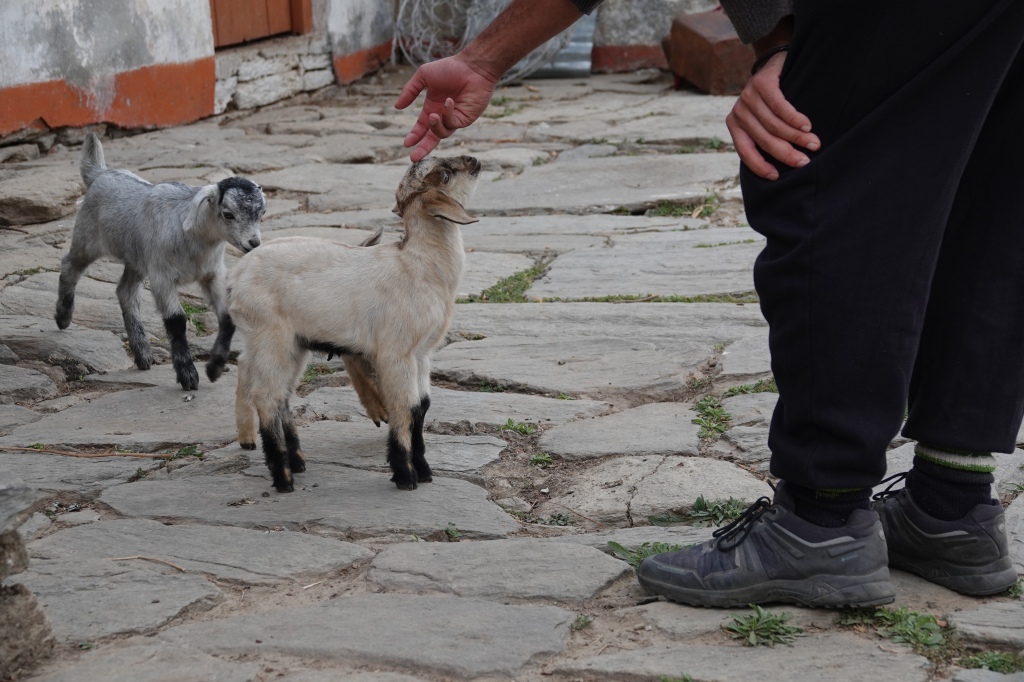

Later that night it turned out it was the same woman’s house where we’d go for Holi. This event, in comparison to the previous festivities seemed a little more sombre – the little children remaining stony faced the whole time we were there; although as always the adults were very welcoming. Feeling too much like outsiders, we suggested we carry on with our walk, and Goodu took us up to a viewpoint, from where we could see for miles, including, yay, the Himalayas.
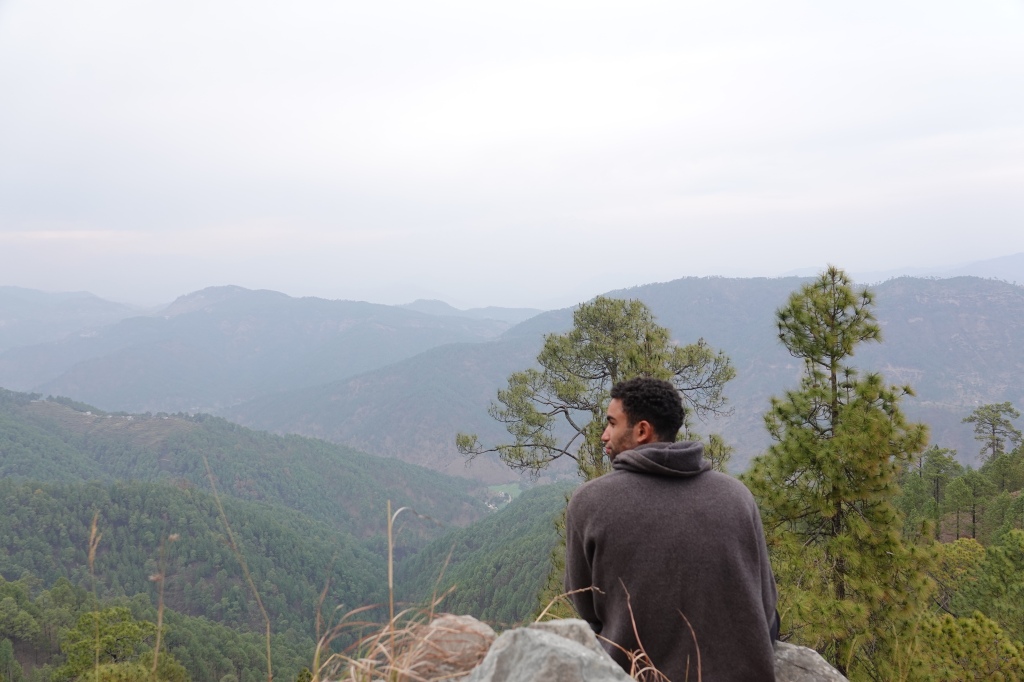
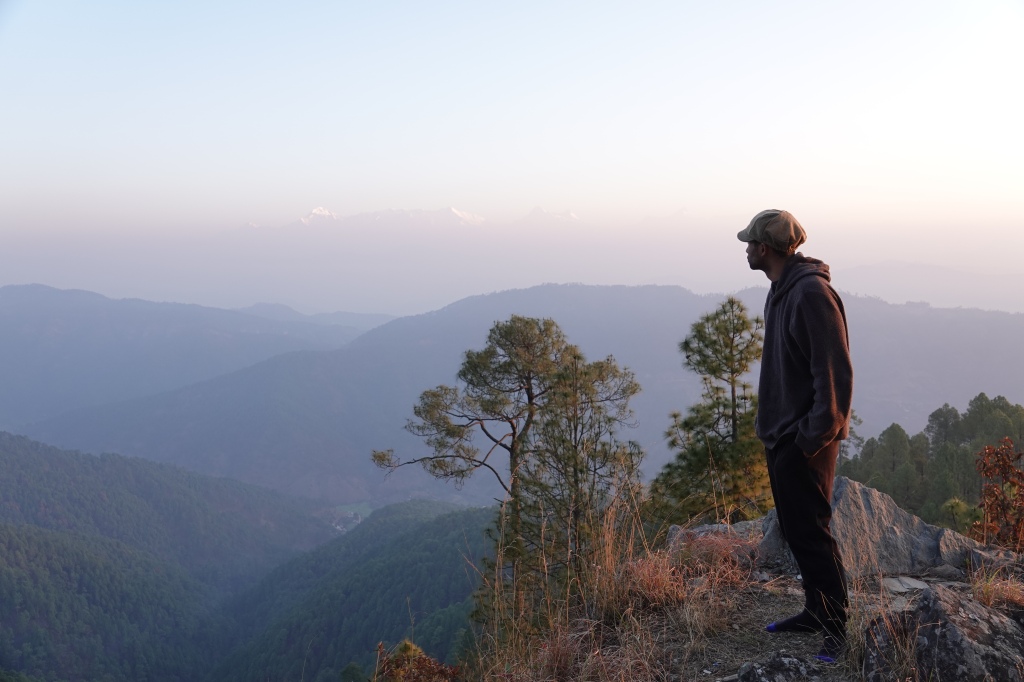
11km: Gonap to Satri (meaning ‘priest’s house)
Satri was undoubtedly our favourite hamlet. On the walk leading up to it we watched boys from a neighbouring village playing cricket on the terrace. We knew they couldn’t be local, as the hamlet is now down to just one couple, who run the homestay. There were five houses still occupied when my sister visited.
Set on the edge of a narrow mountain ridge, painted in blue and white, our homestay room was beautifully decorated, and the couple who ran it were equally lovely. Very smiley and sociable, so we were glad for their sakes that they had regular visitors. Although when they’re no longer there, I guess the village will just fall to ruins (despite the fact it would be a killer location for a hotel).

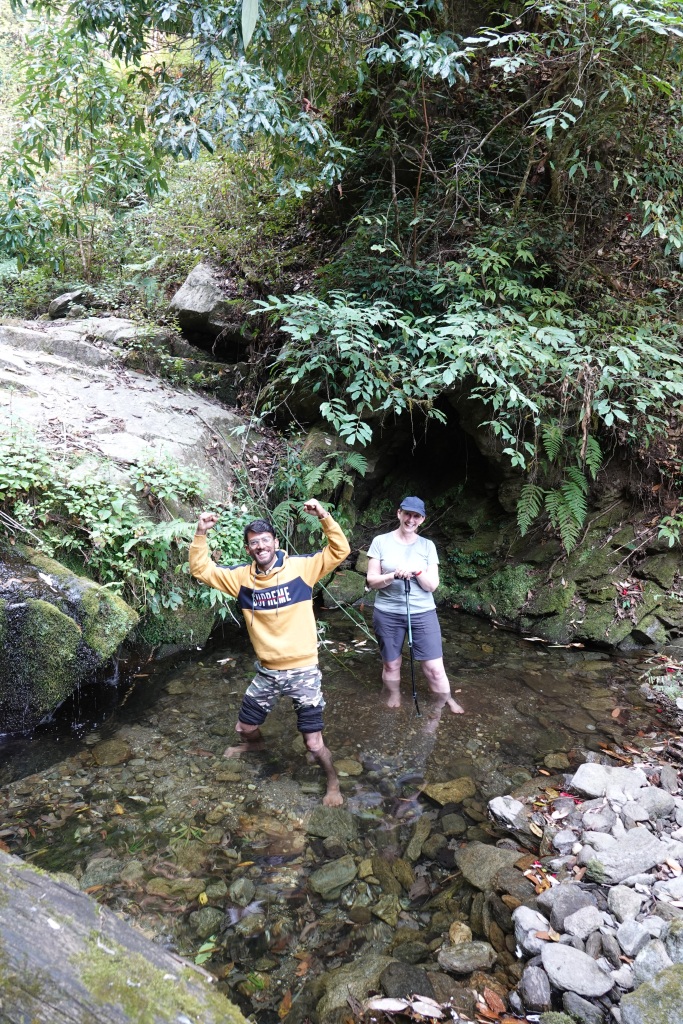
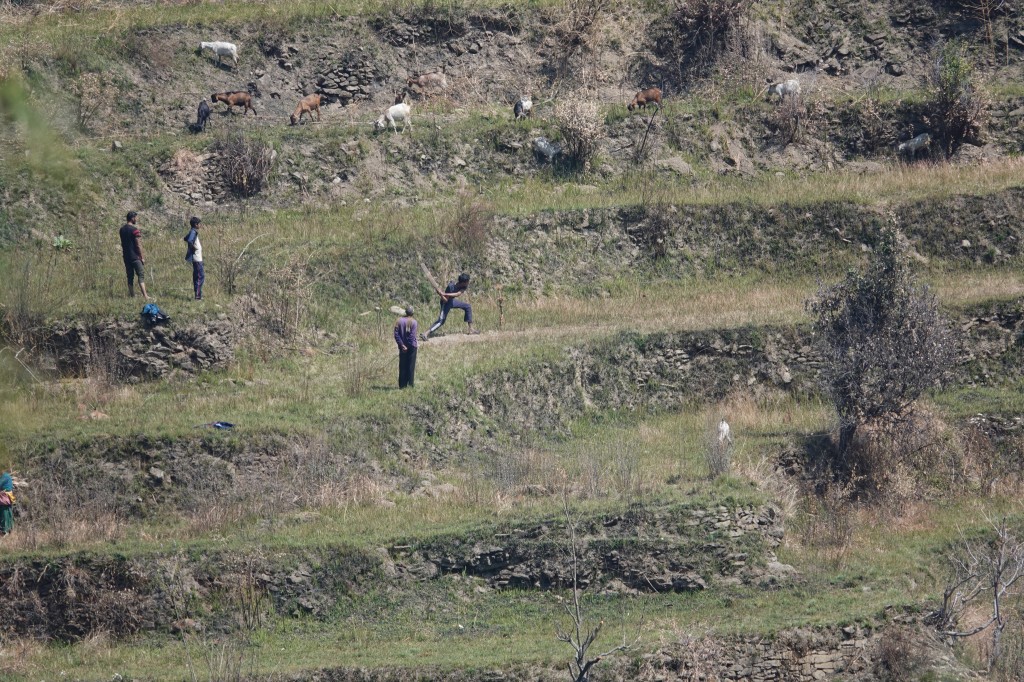

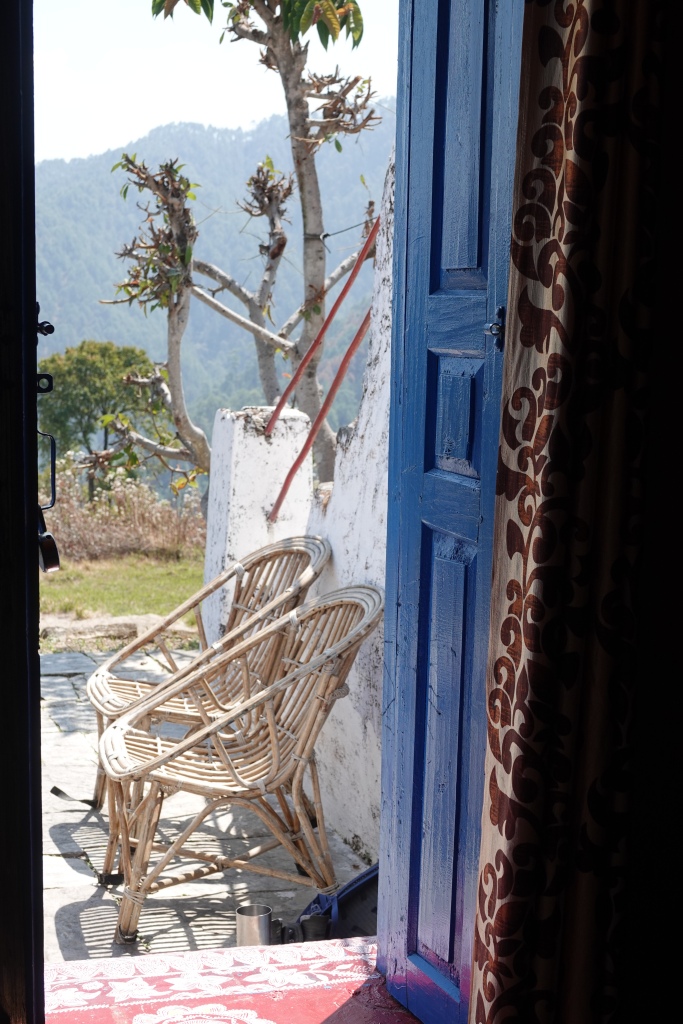
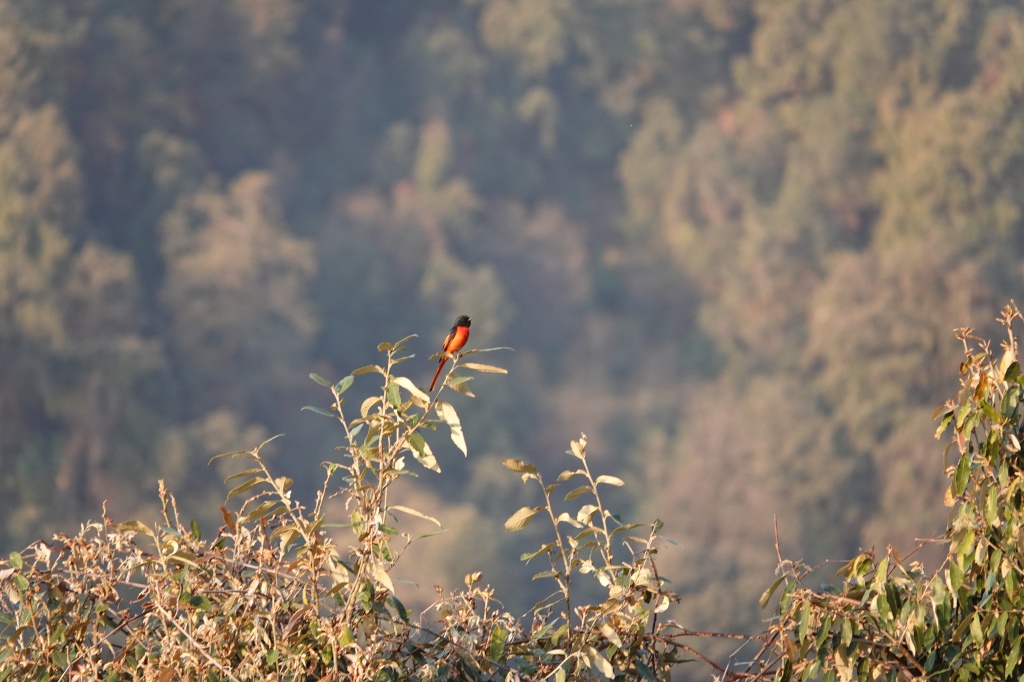
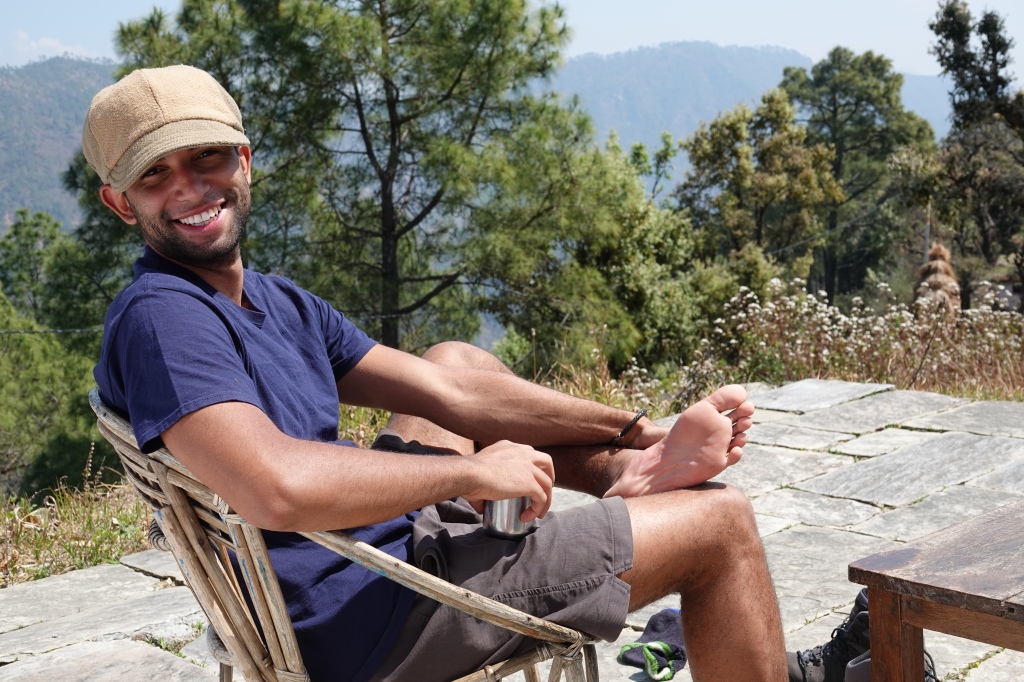
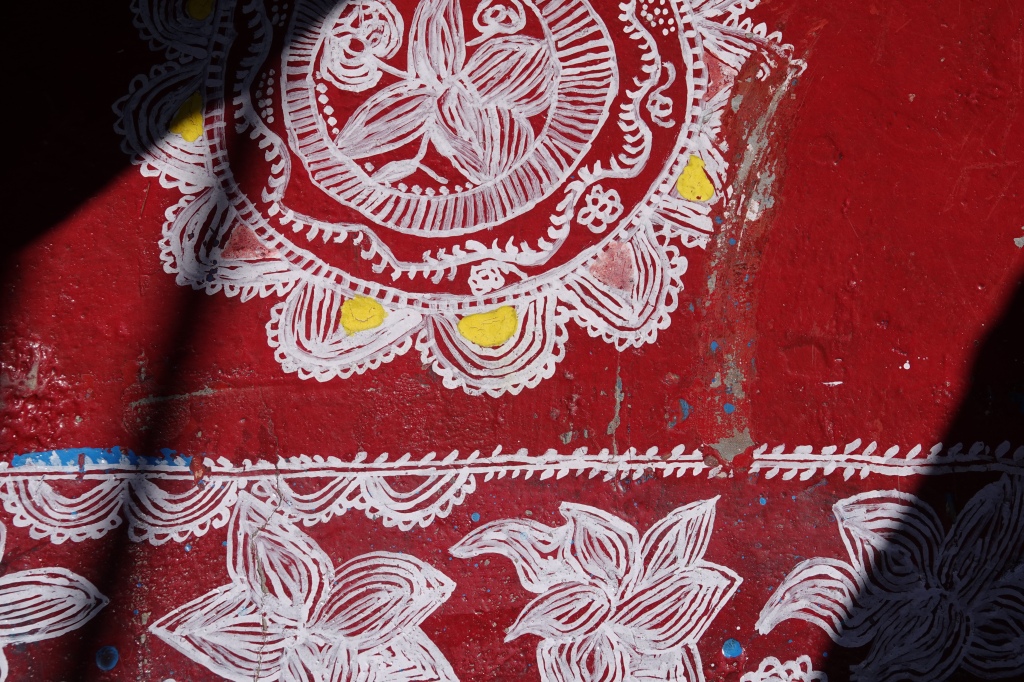
Tonight was the male version of Holi, and I must grudgingly admit that this one was particularly well organised. Despite being female, I was welcomed to sit and watch as the men danced around small fires in various temples spread across the hills. Then they were given more potatoes, and tea etc, but this time cigarettes and alcohol were added into the mix. There were some real characters (including a man who looked rather like Jonny Depp) and I loved trailing in their joyful wake as they danced and sang all around the hamlet, ending finally on the terrace of our hosts, where yet more food, tea and cigarettes were generously served.
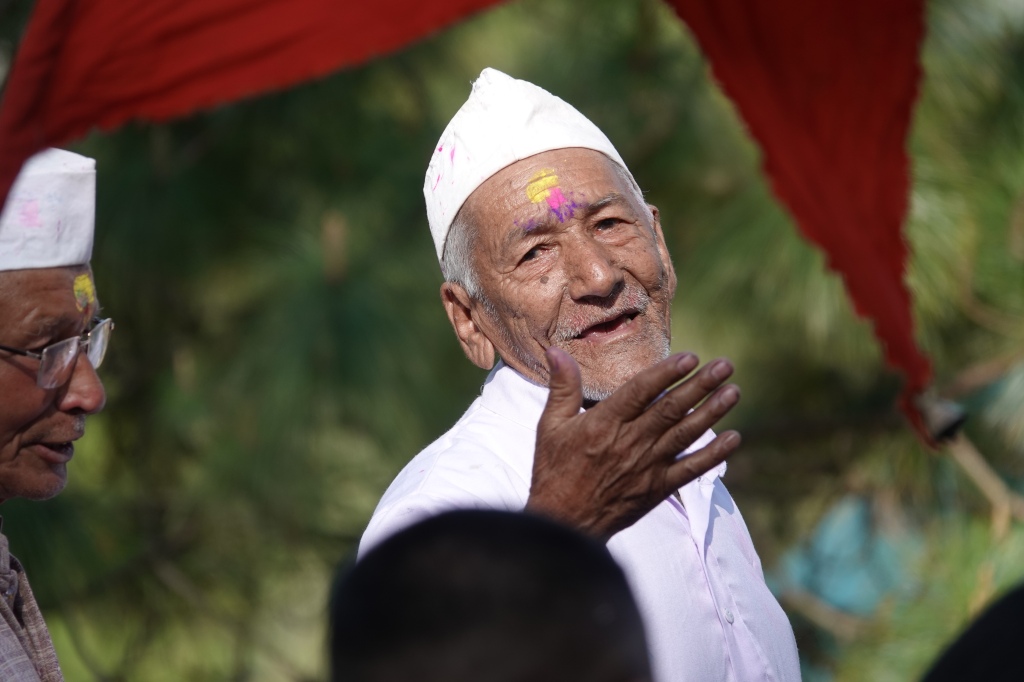
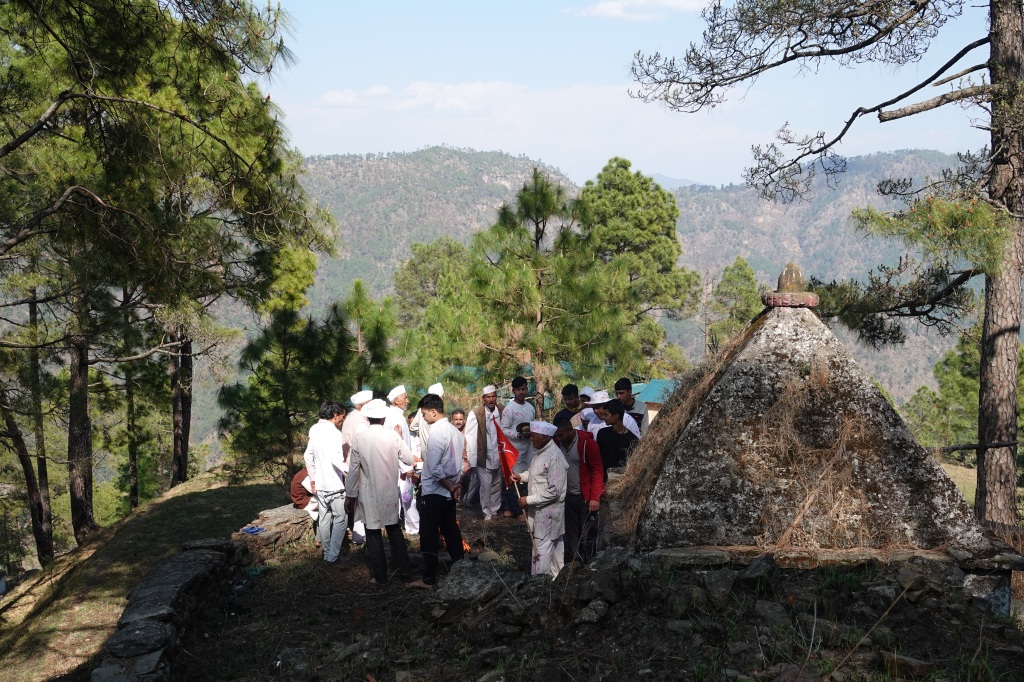
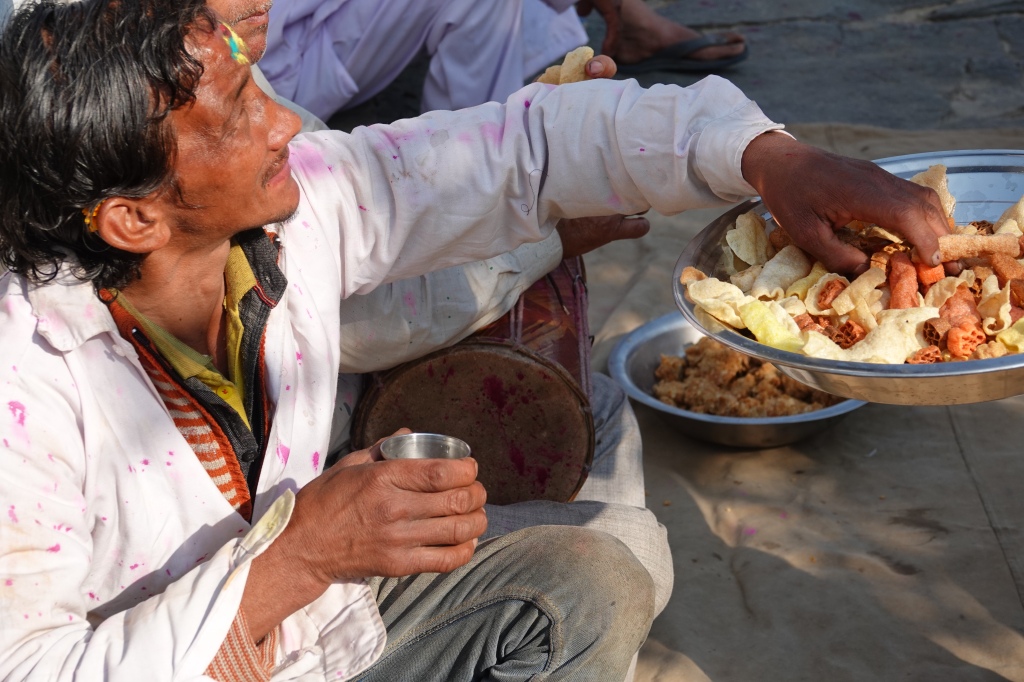
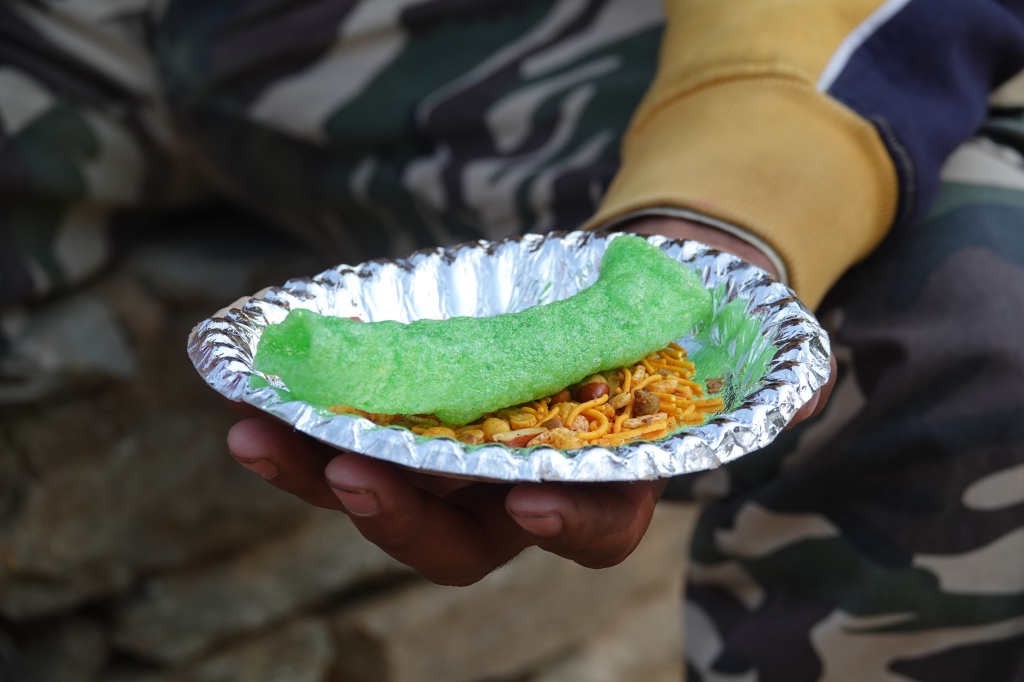

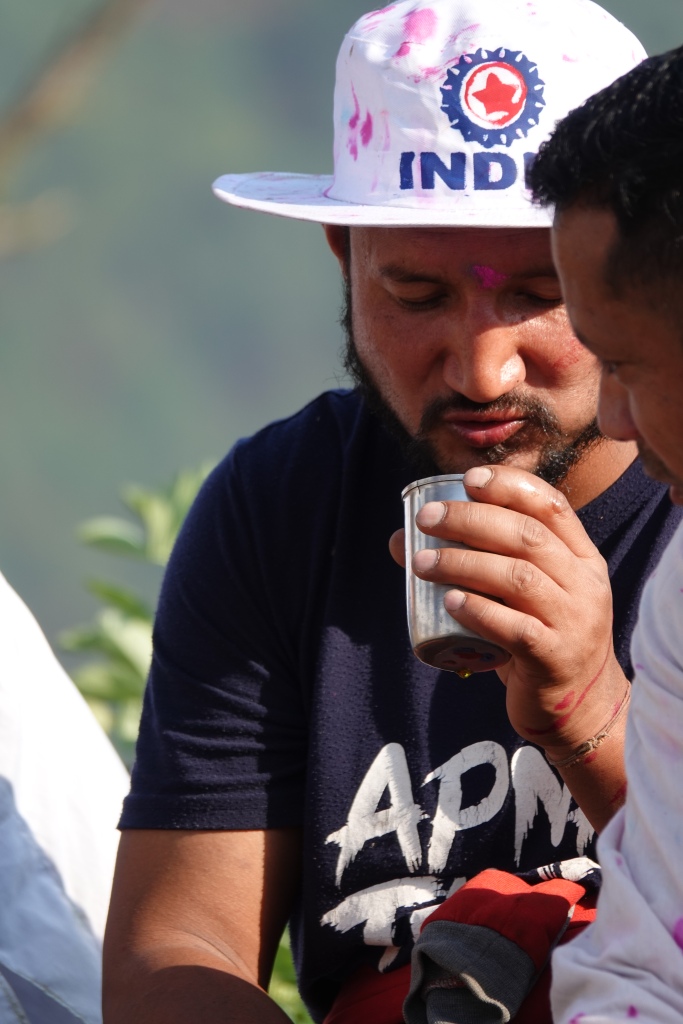


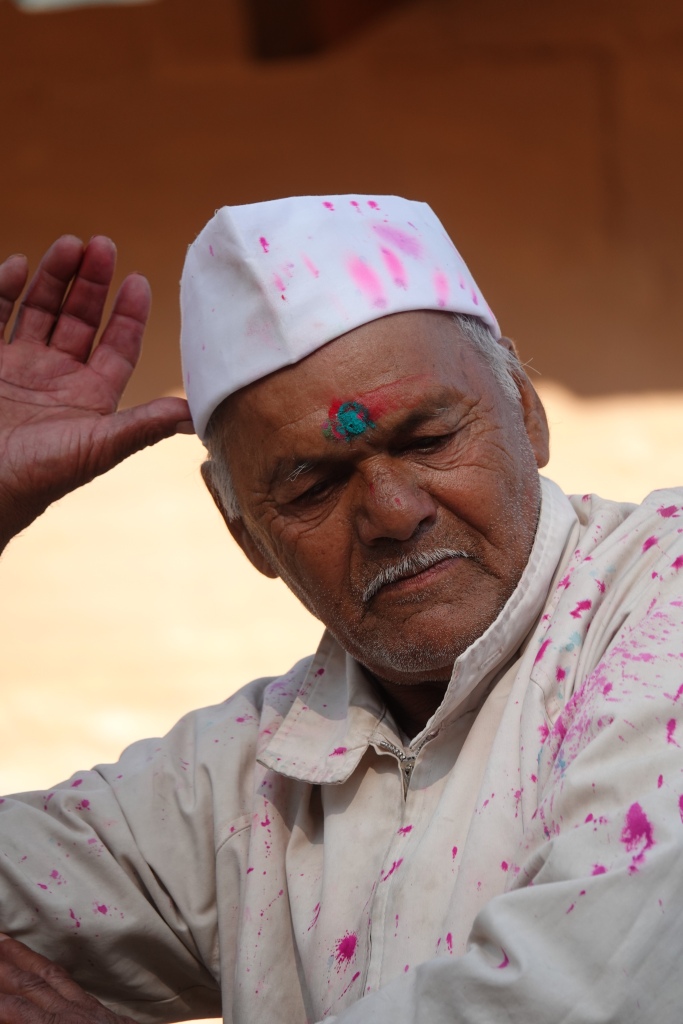
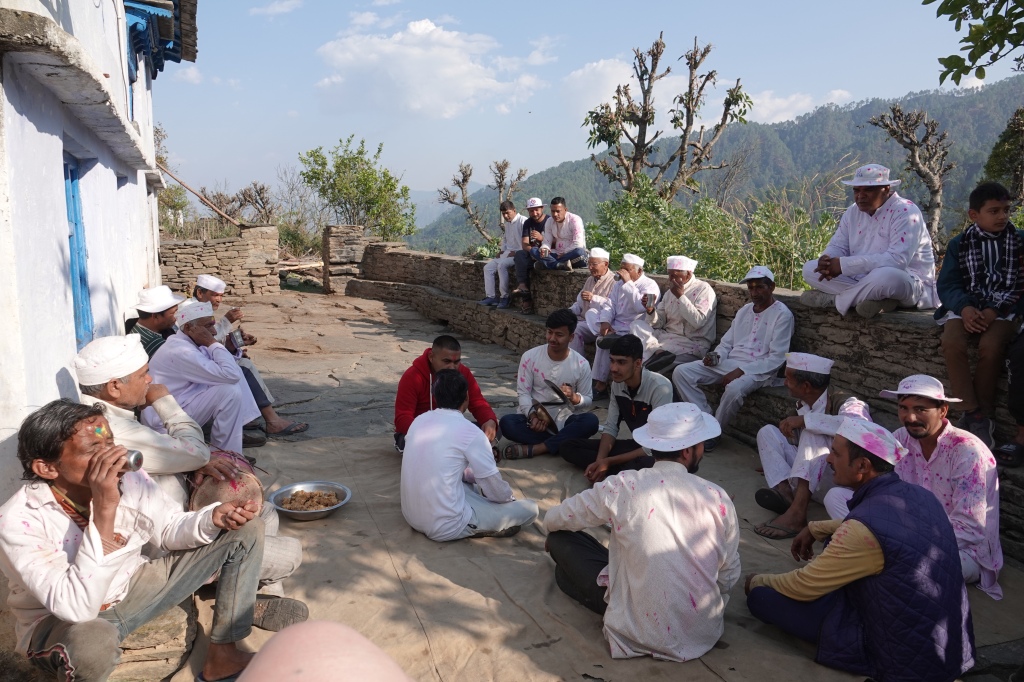
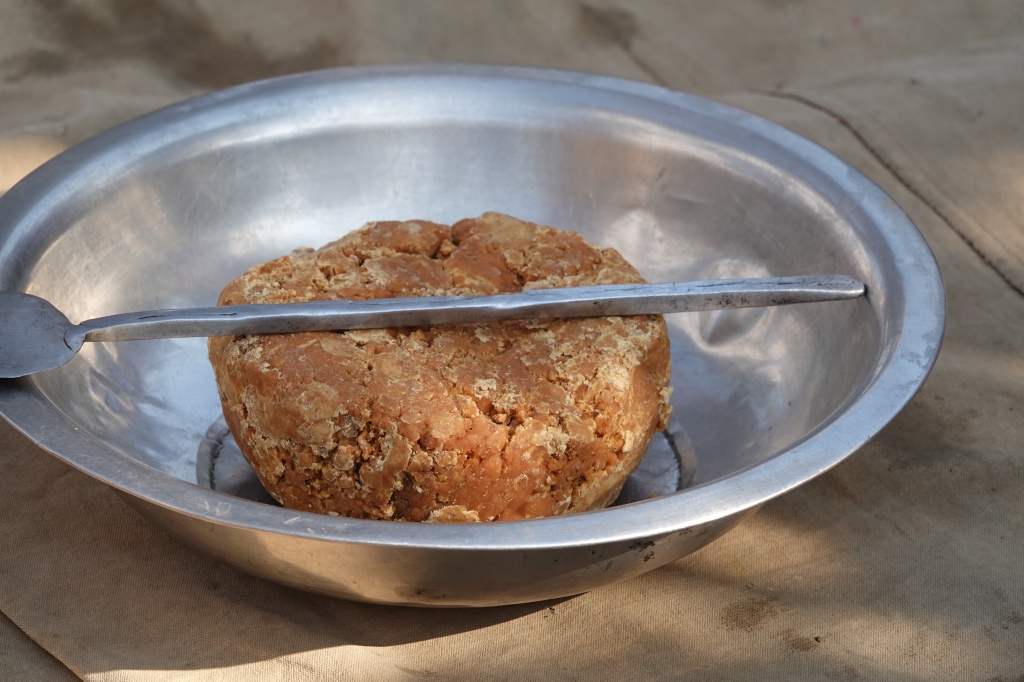

For Jai, however, the highlight of the evening was undoubtedly borrowing Bhupal’s internet hotspot so he could text his girlfriend. We’d actually loved being out of wifi contact, but that ten minutes communication (beginning with a stream of texts waiting for him in his in-box) made all the difference – as well as sustaining him for another six days off-grid. Generally, however, having no internet was one of the loveliest aspects of the trip. One night Jai and I huddled on one of the beds, going through all his photos from his gap year (most of which I’d never seen); other nights we listened to Audible books. Rather bizarrely the first was Spare, written by a favourite writer of mine, J R Moehringer, meaning that we spent an unexcepted amount of time discussing the Royal Family. We also ate alone every night, facing each other across small wooden tables, and I was delighted by how easily conversation came. Although don’t think we were chatting well into the small hours. Most evenings we were in bed and asleep by eight-thirty! Supper tonight was beedi-infused (the small cigarette having fallen from behind our host’s ear into the rice when he was cooking). It looked quite okay when I handed it back, so I wonder if he smoked the rest of it.
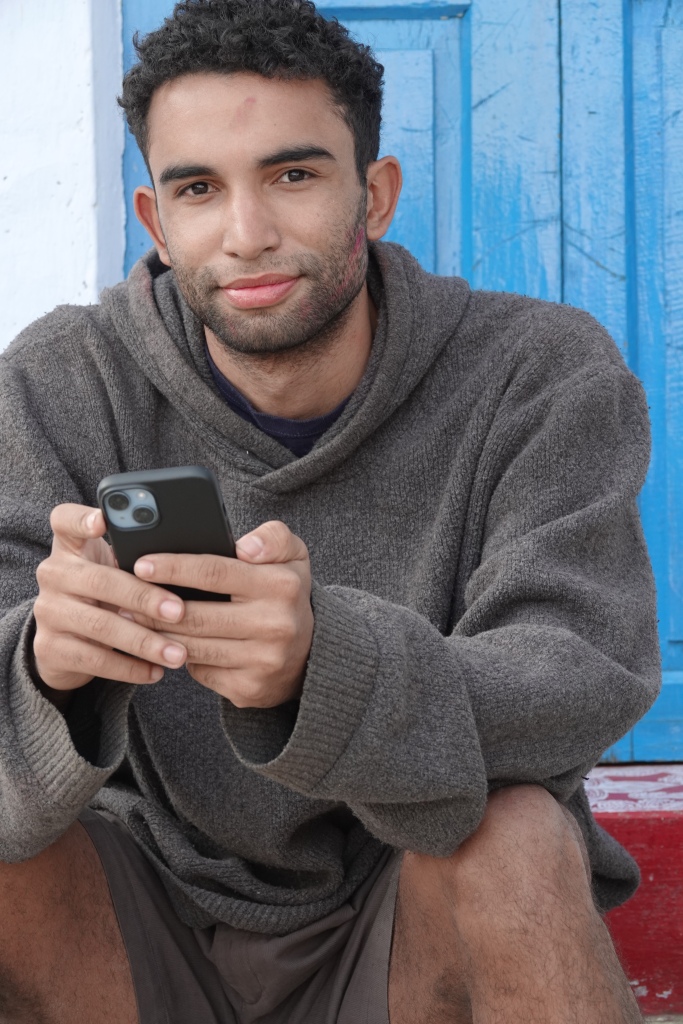

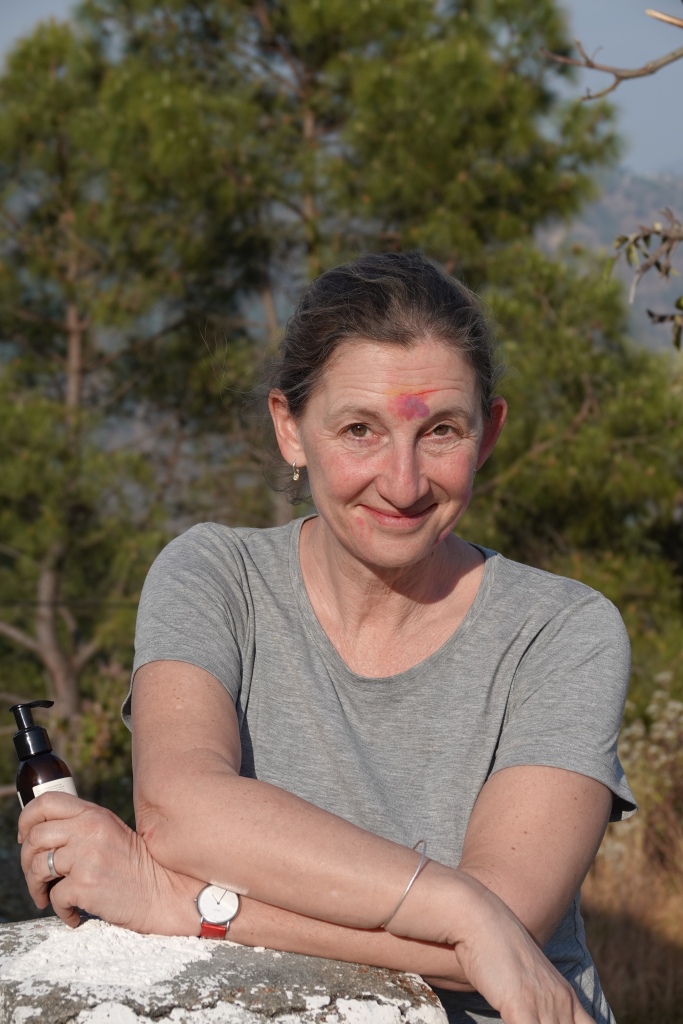

The next morning we said goodbye to Goodu and Bhupal, thanking them profusely for having been just the best guiders. We were off down one side of the mountain, they the other. There was only one guide who came to meet us, and it took a bit of convincing to make them let Jai carry his own backpack – a plan that soon failed when a woman appeared on the mountain path and insisted he hand it over!
Passing bucolic scenes of washing hanging on bushes and pecking chickens and slumbering goats and cattle, when we reached the road we stood waiting for our taxi, watching women dancing in a temple on a nearby hill, birds flitting in and out of the eaves above us as we chatted to an Indian family who’d been staying on the mountain and were now about to drive the eleven hours back to Delhi. Little did we realise, immersed in that pleasant morning, that within a few hours we’d be fearing for our lives on the next step of the journey. To find out why, you can read about the second part of the trip here.
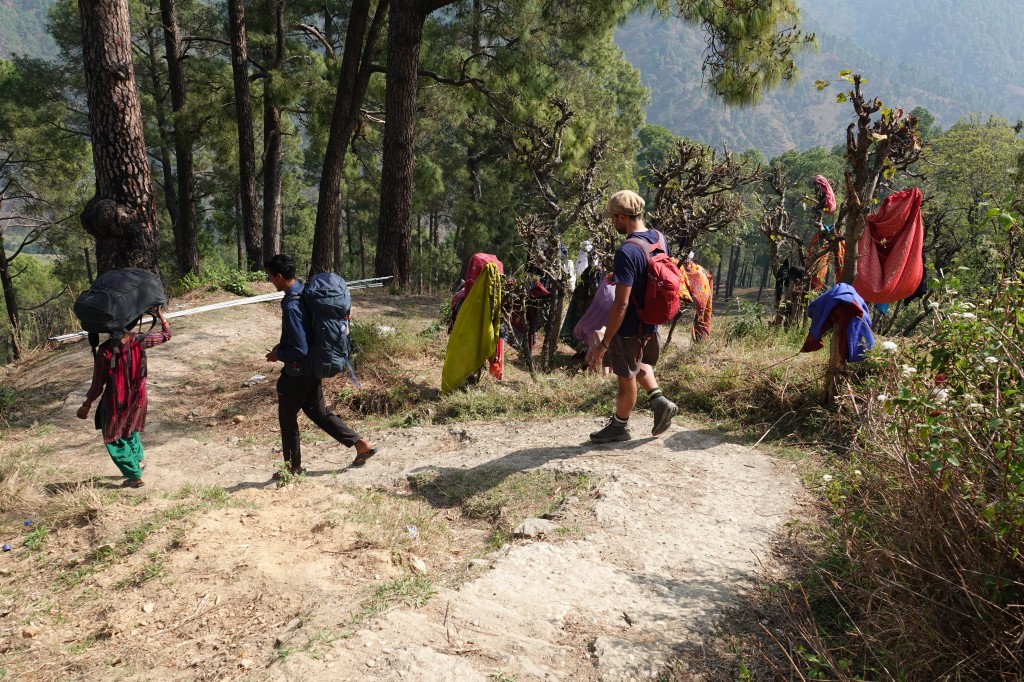
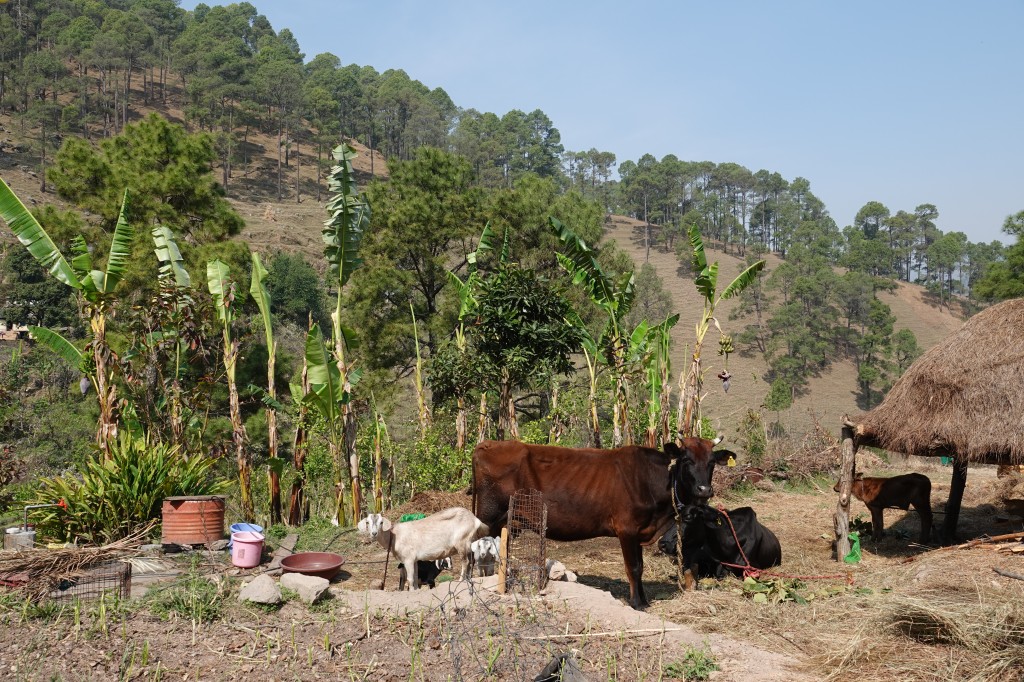
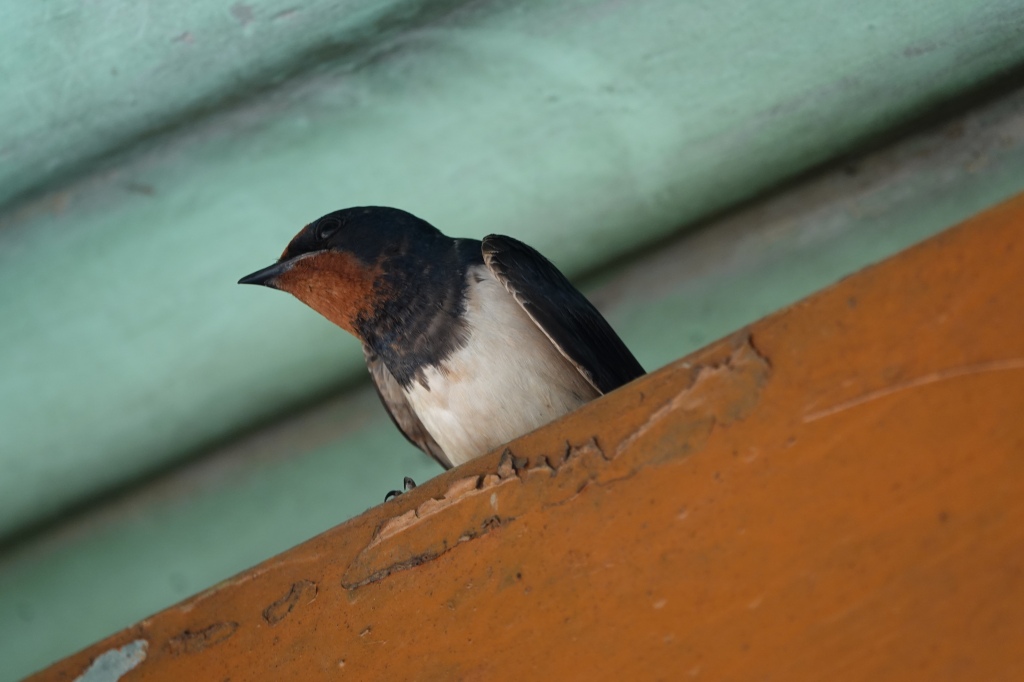

[1] Cannabis is illegal, but ‘very popular’.

